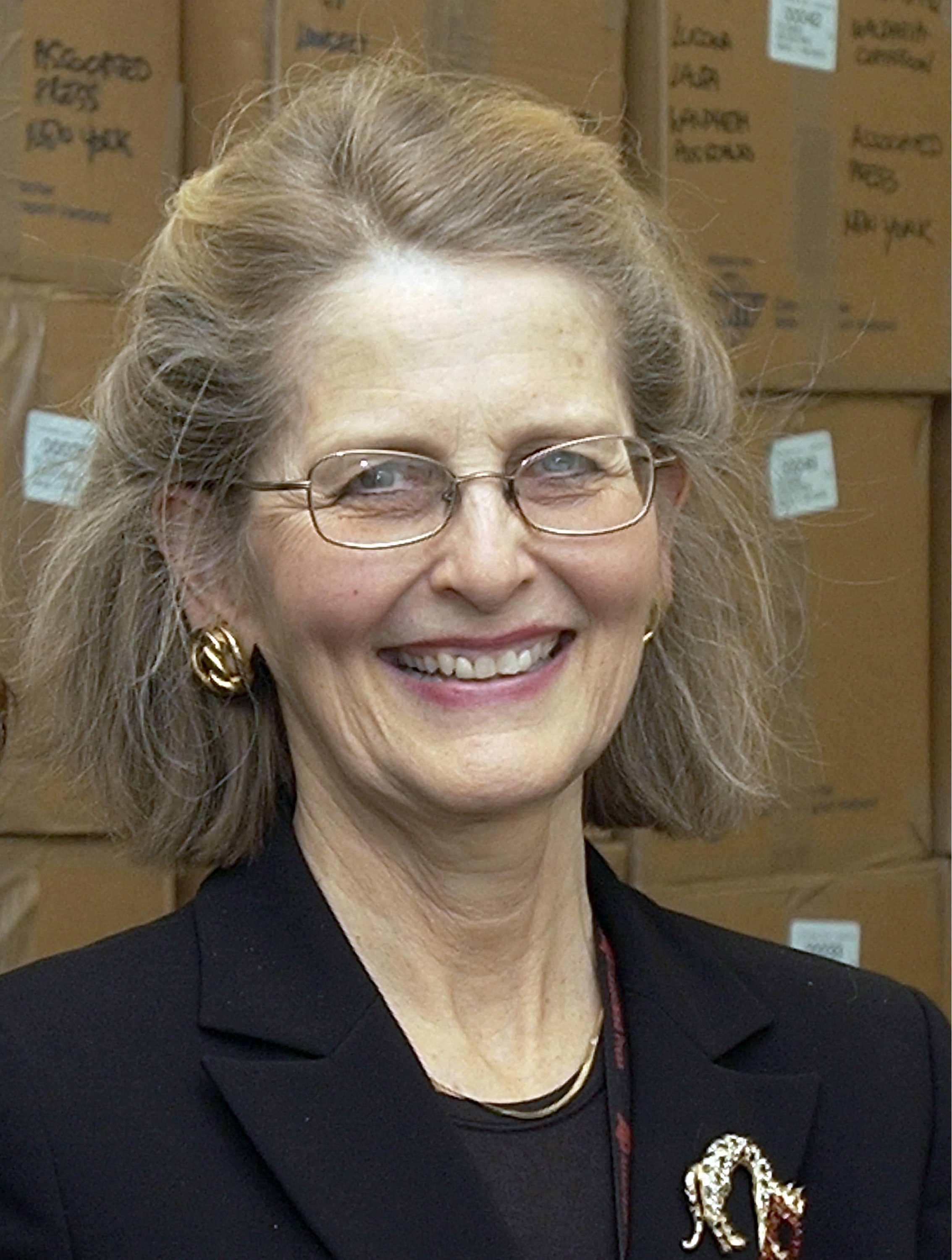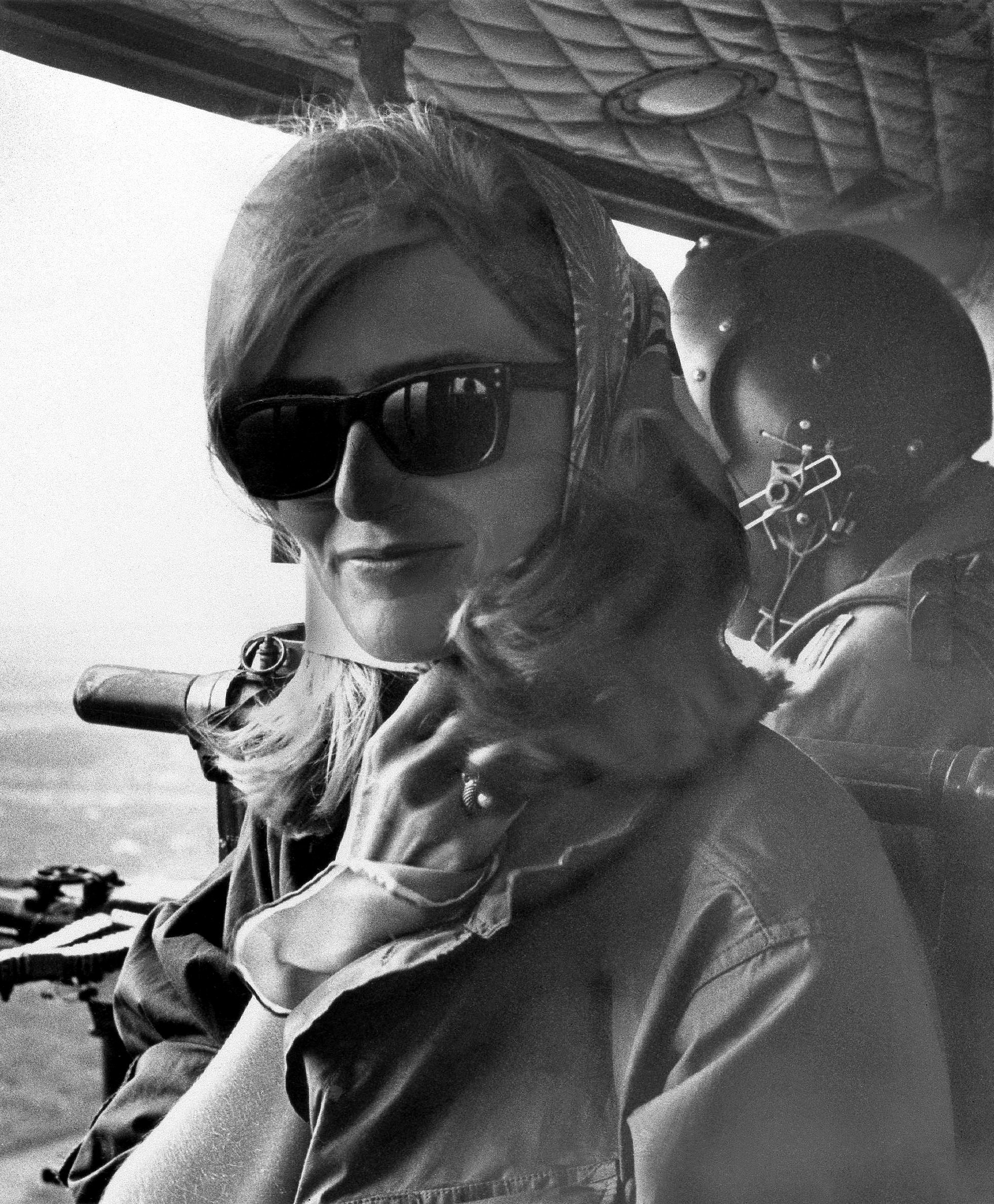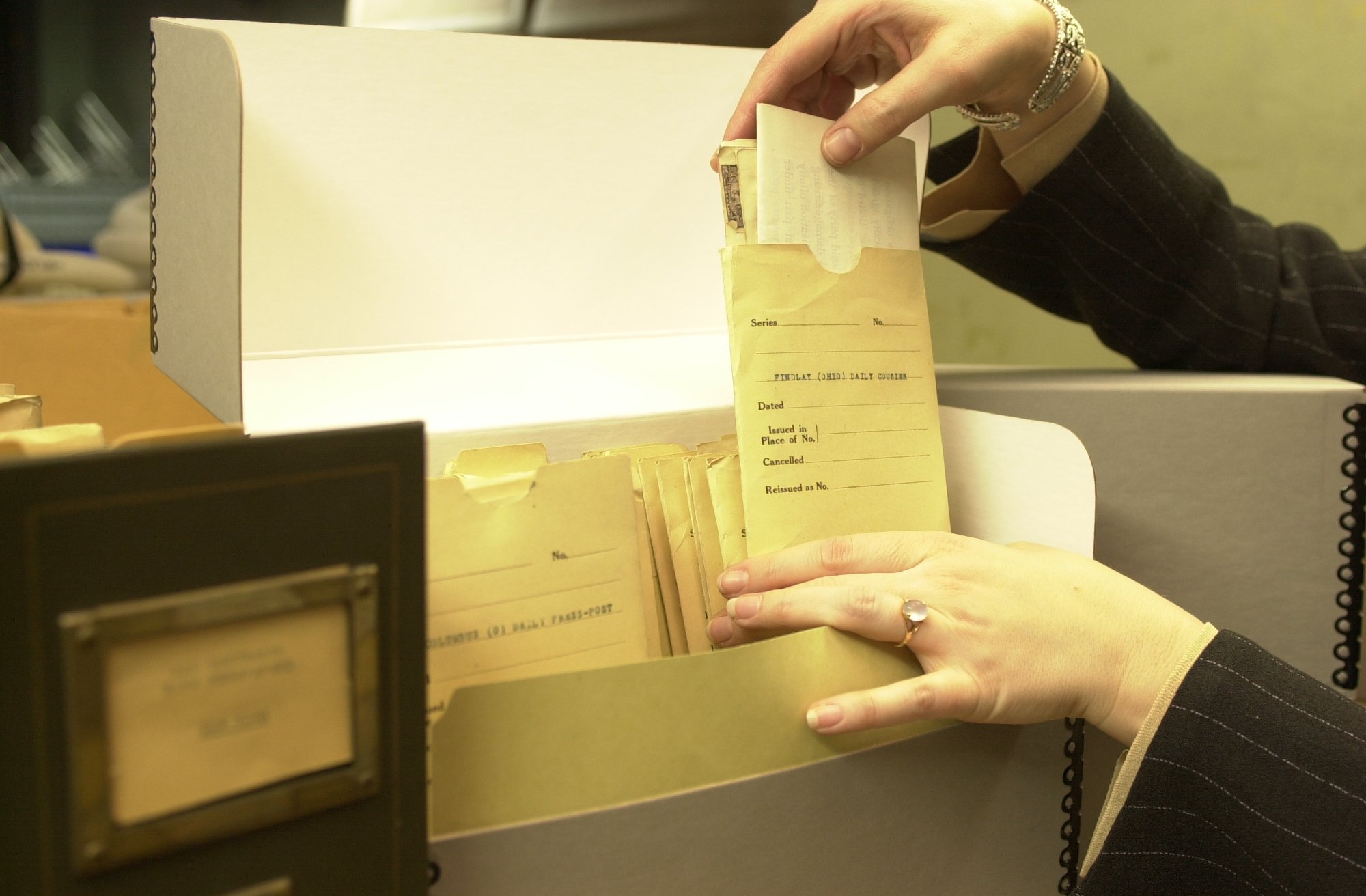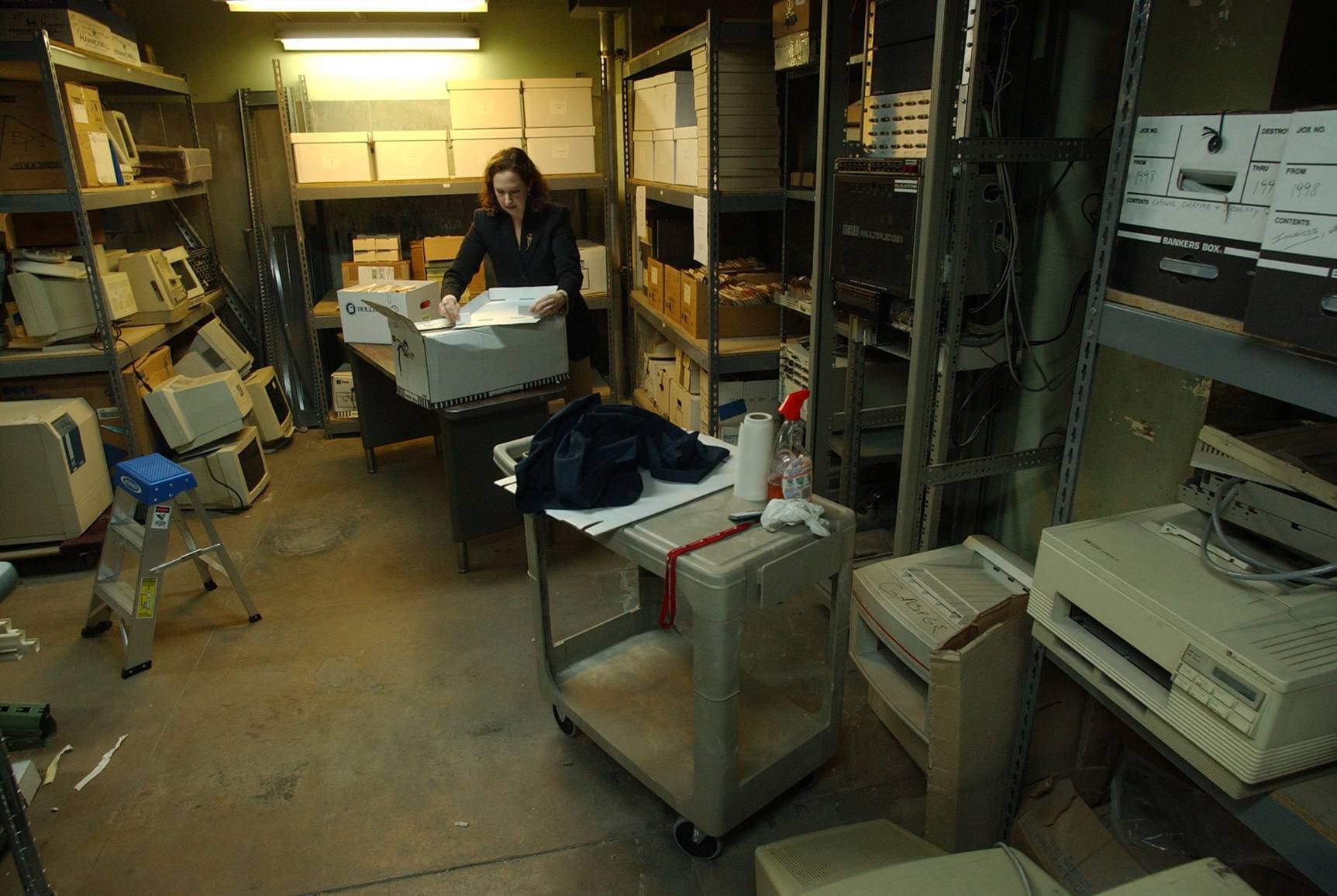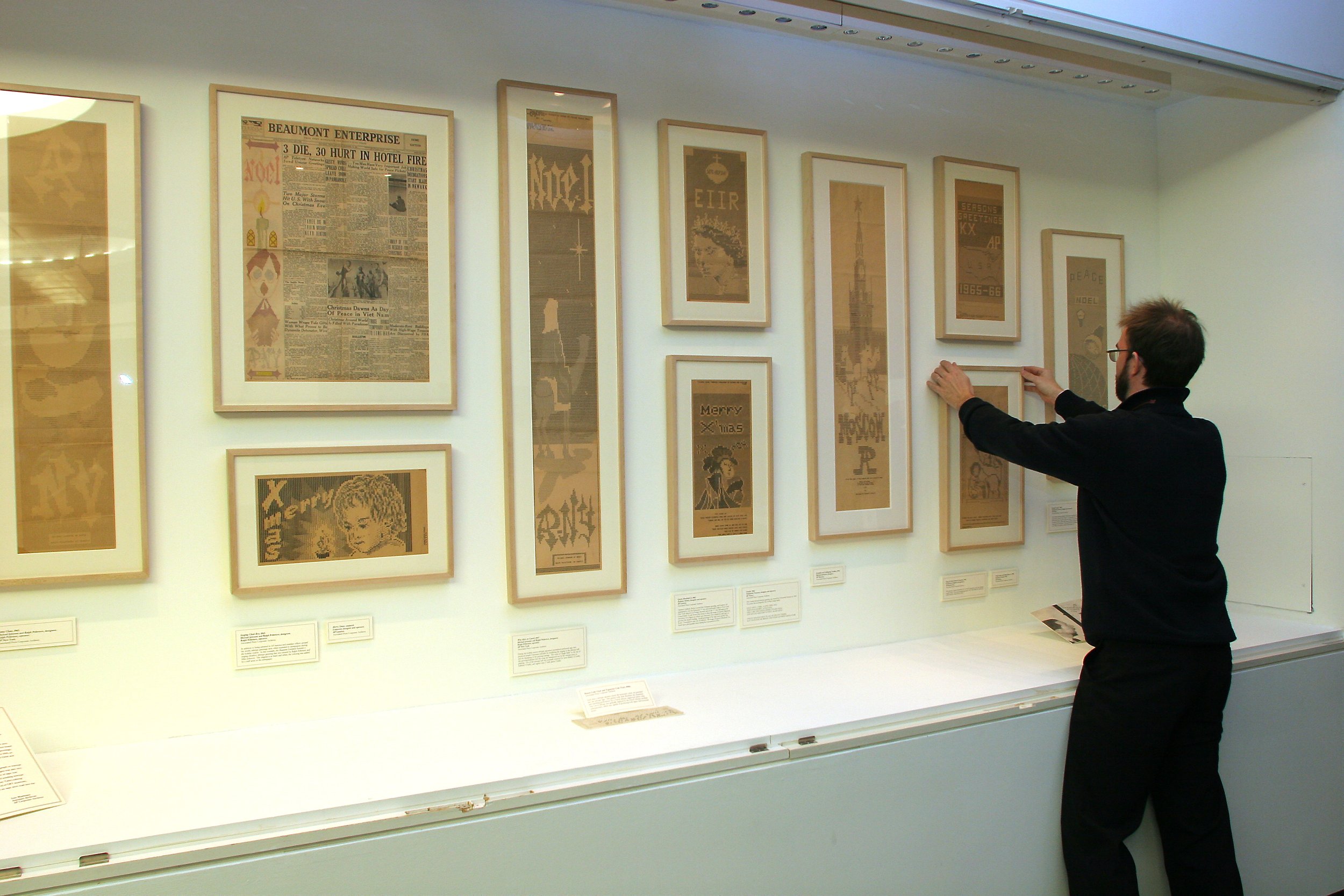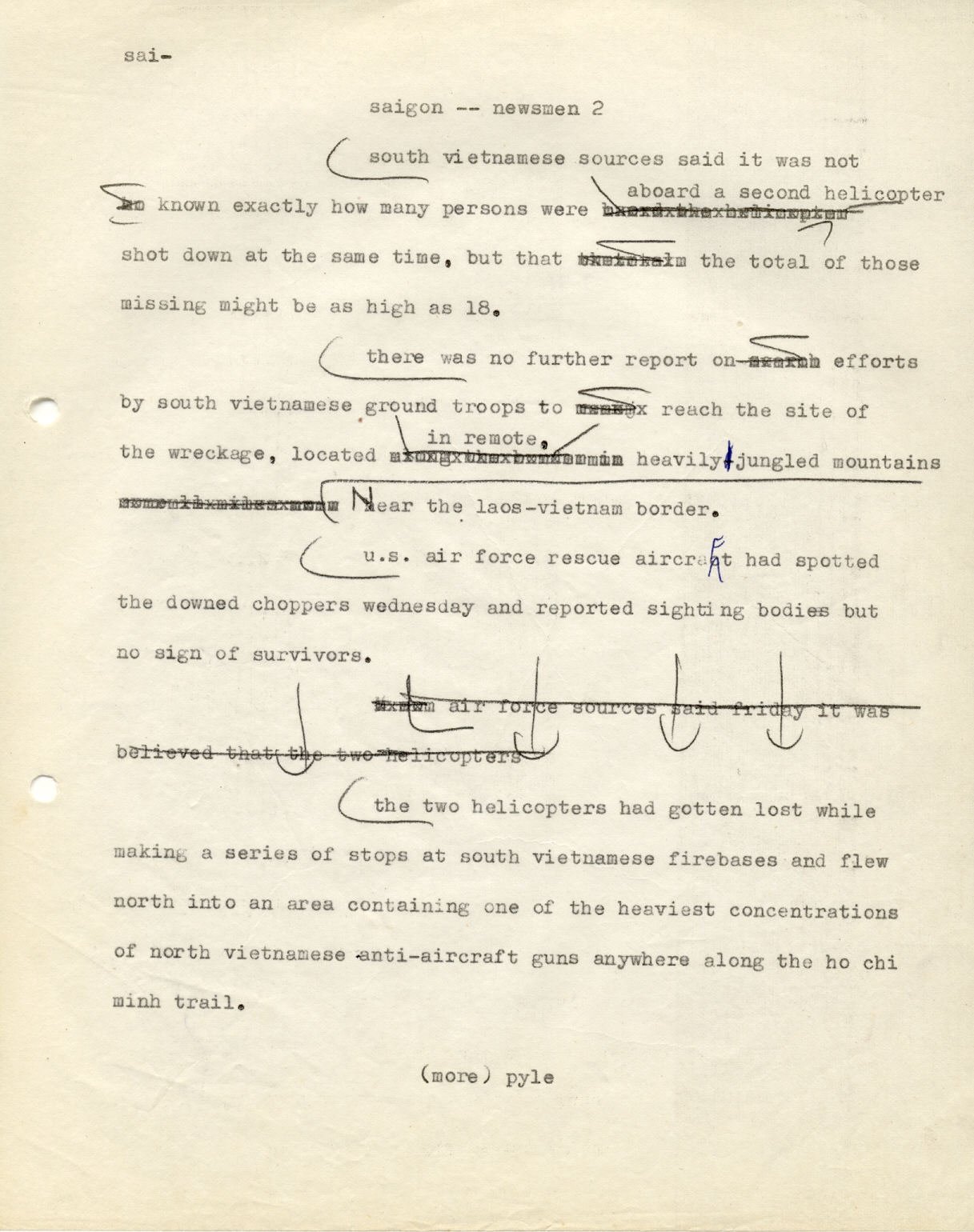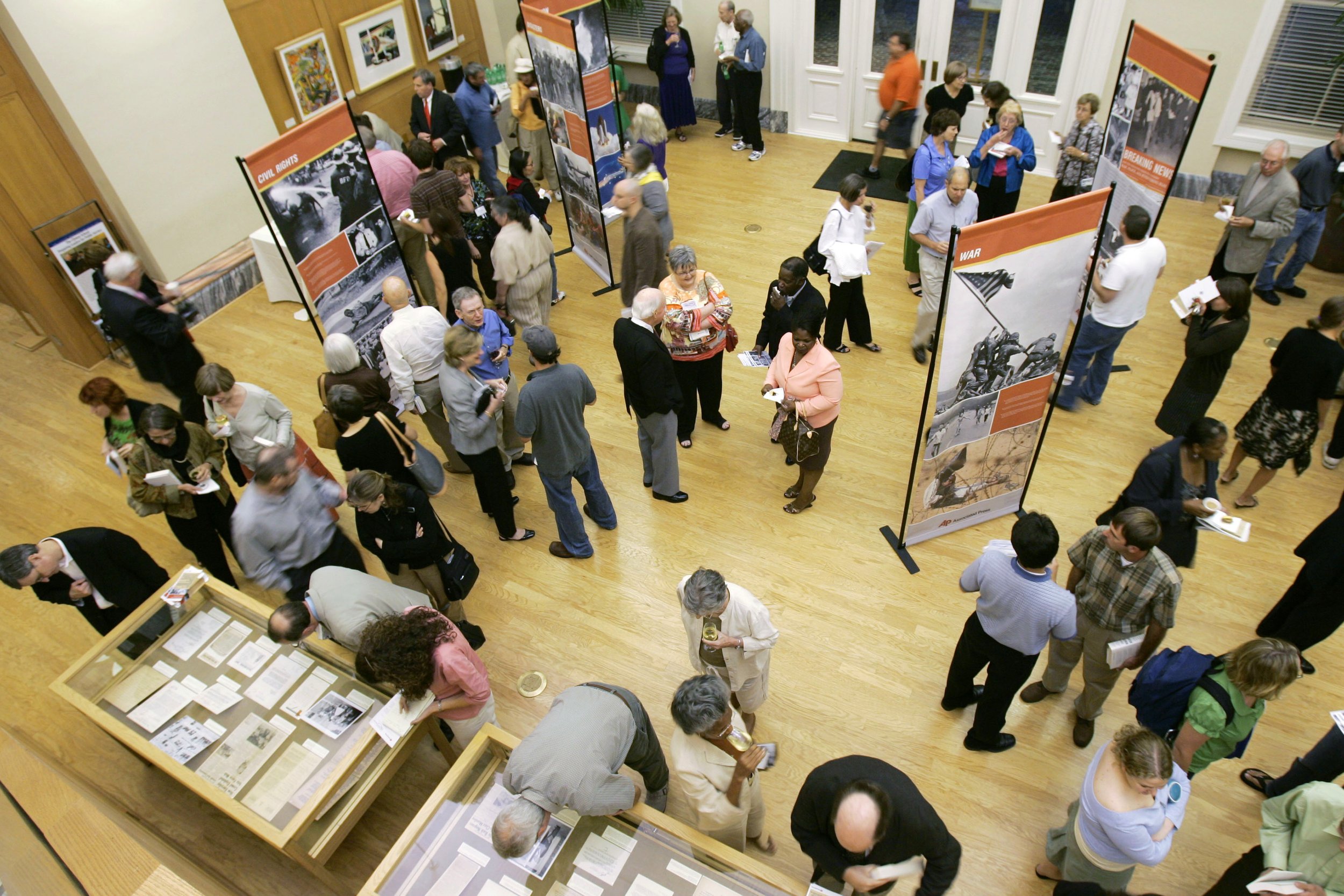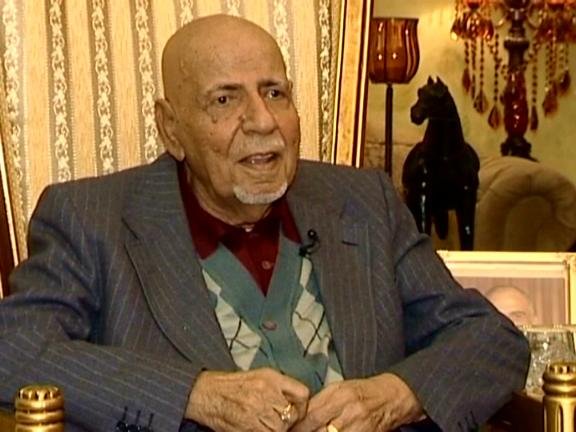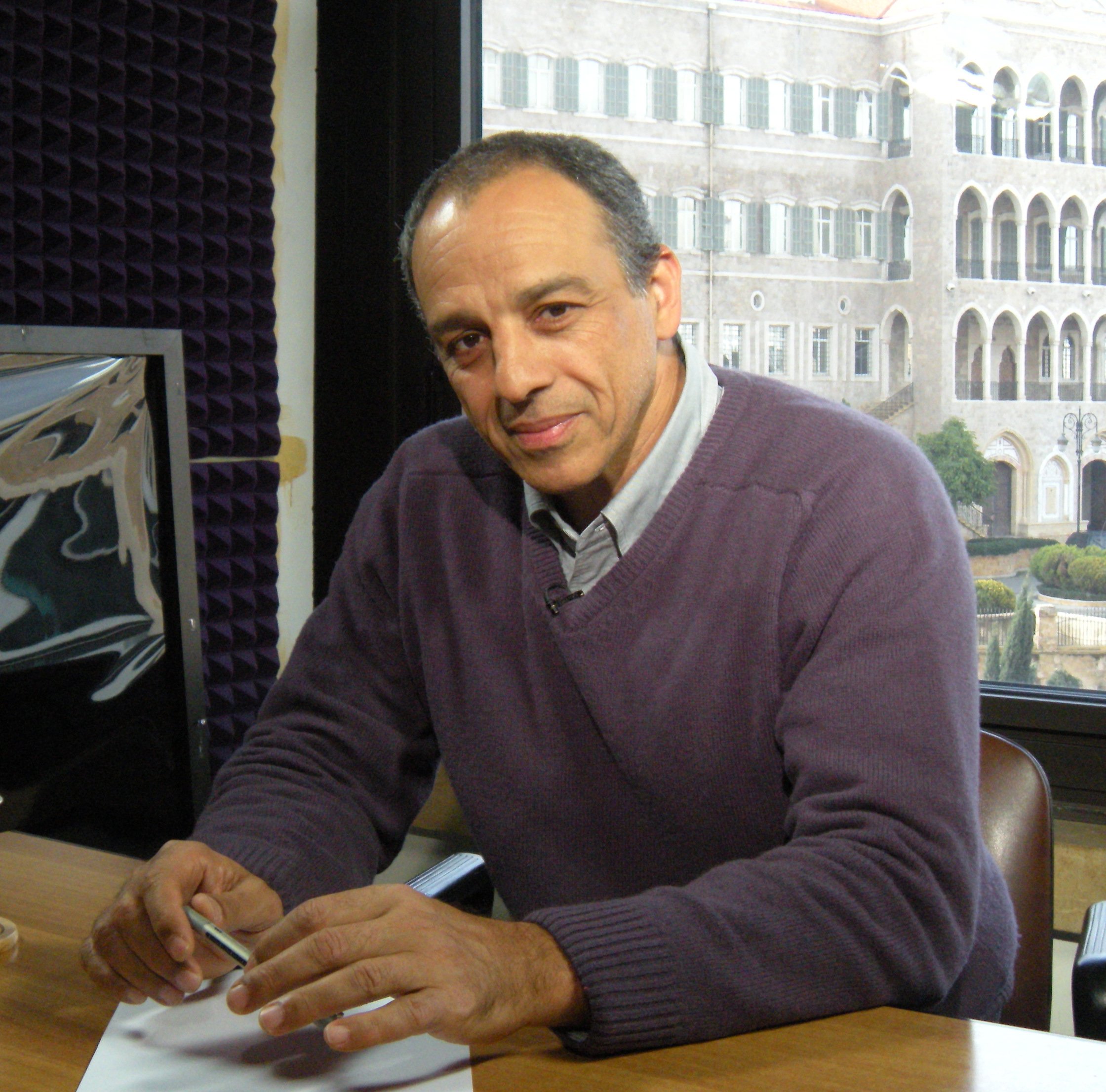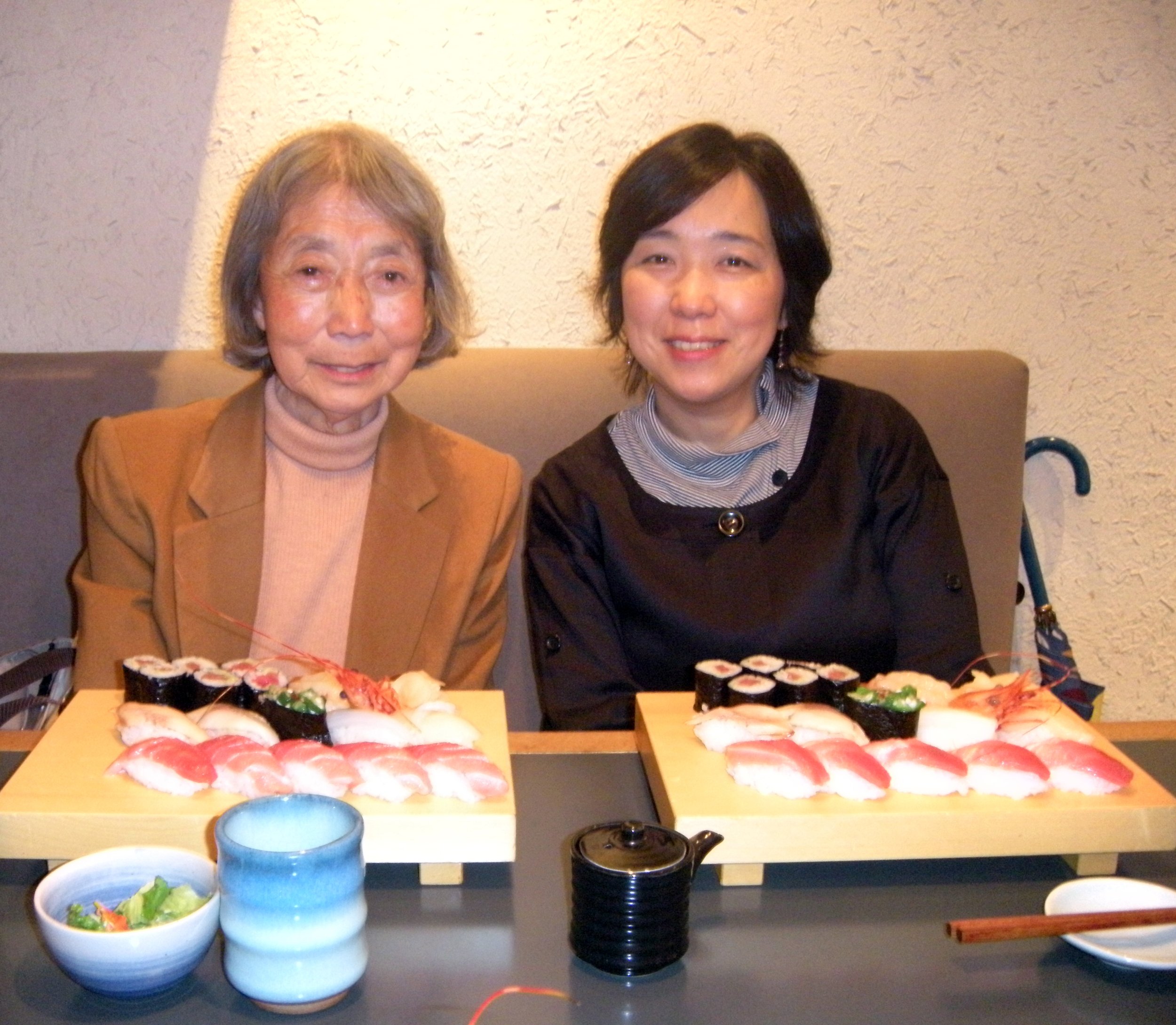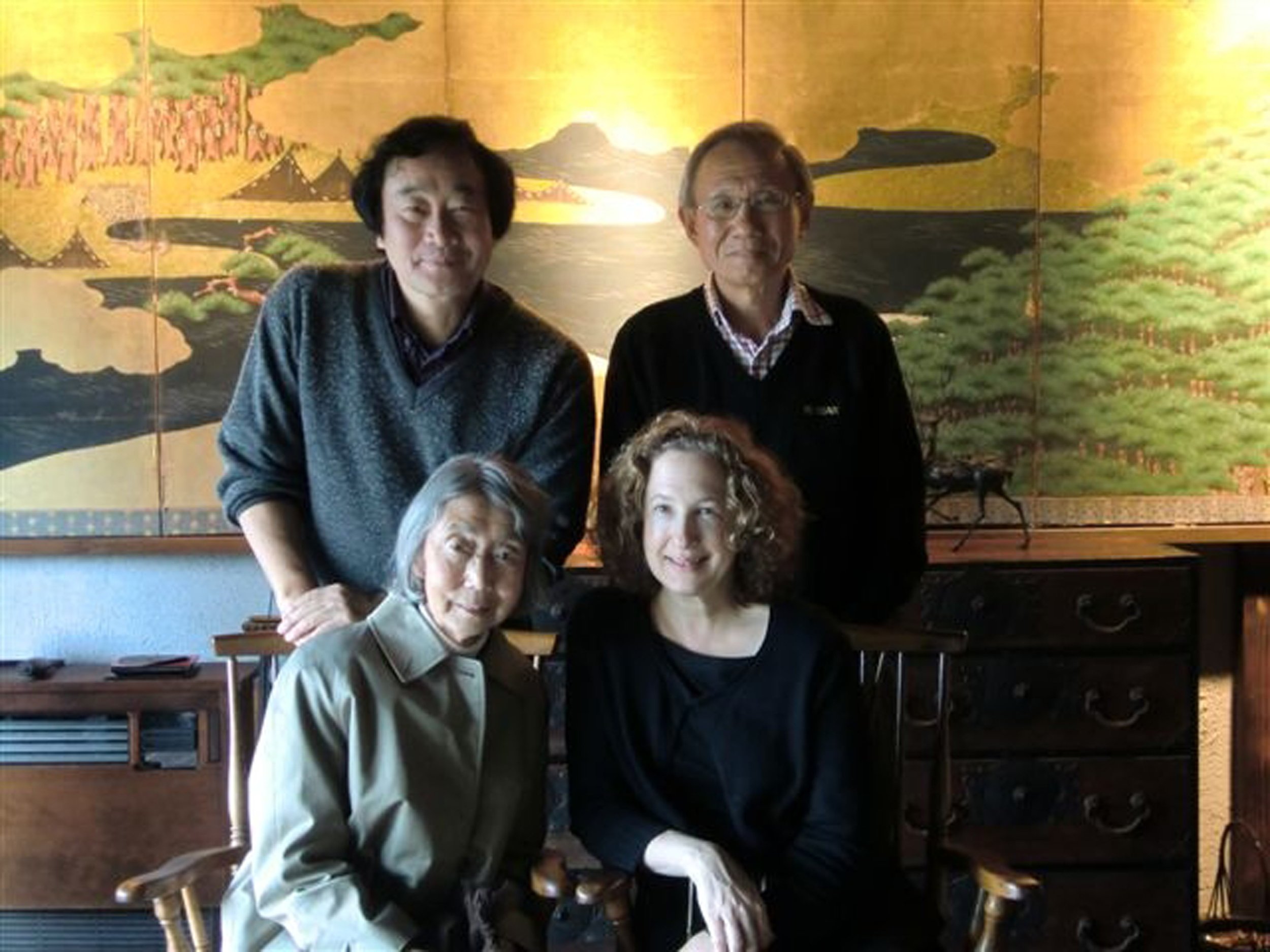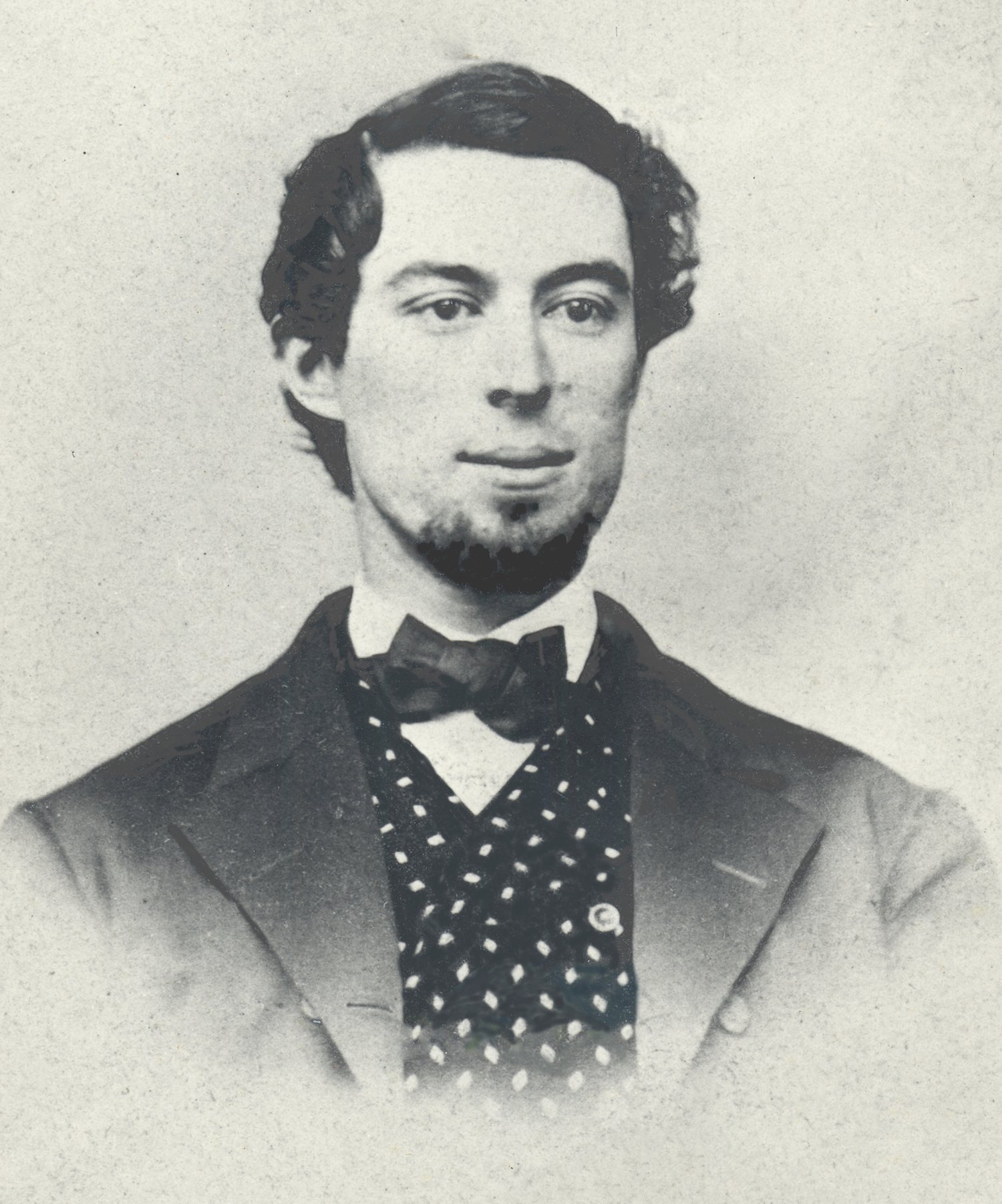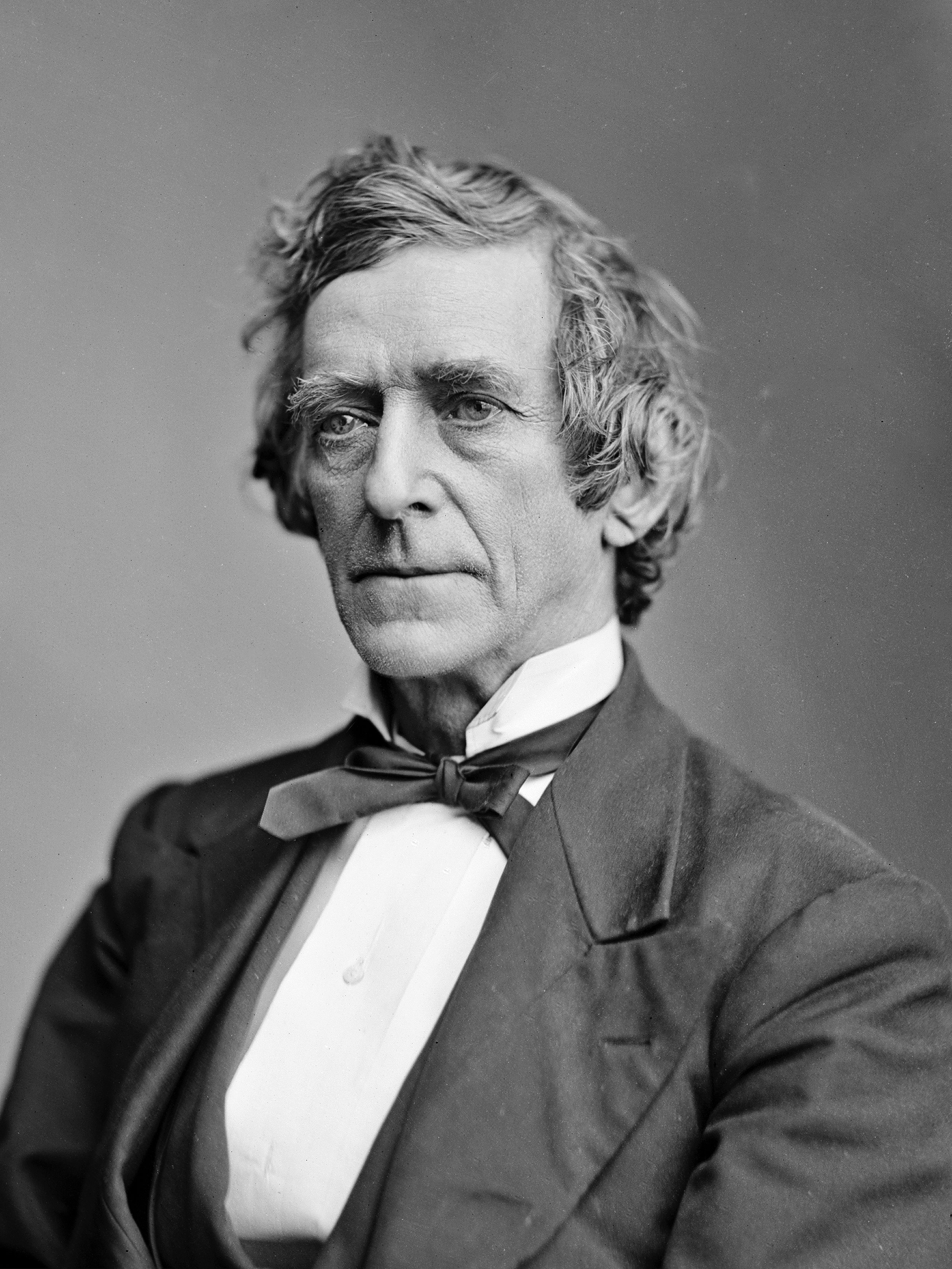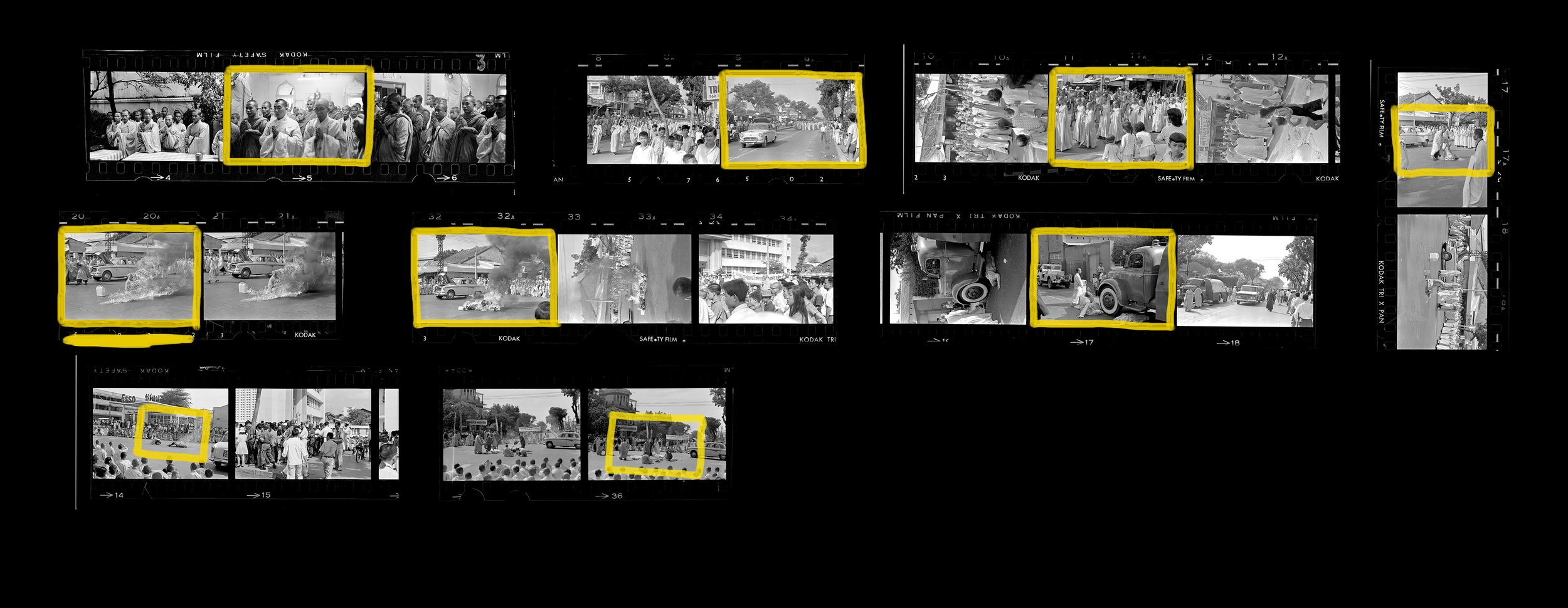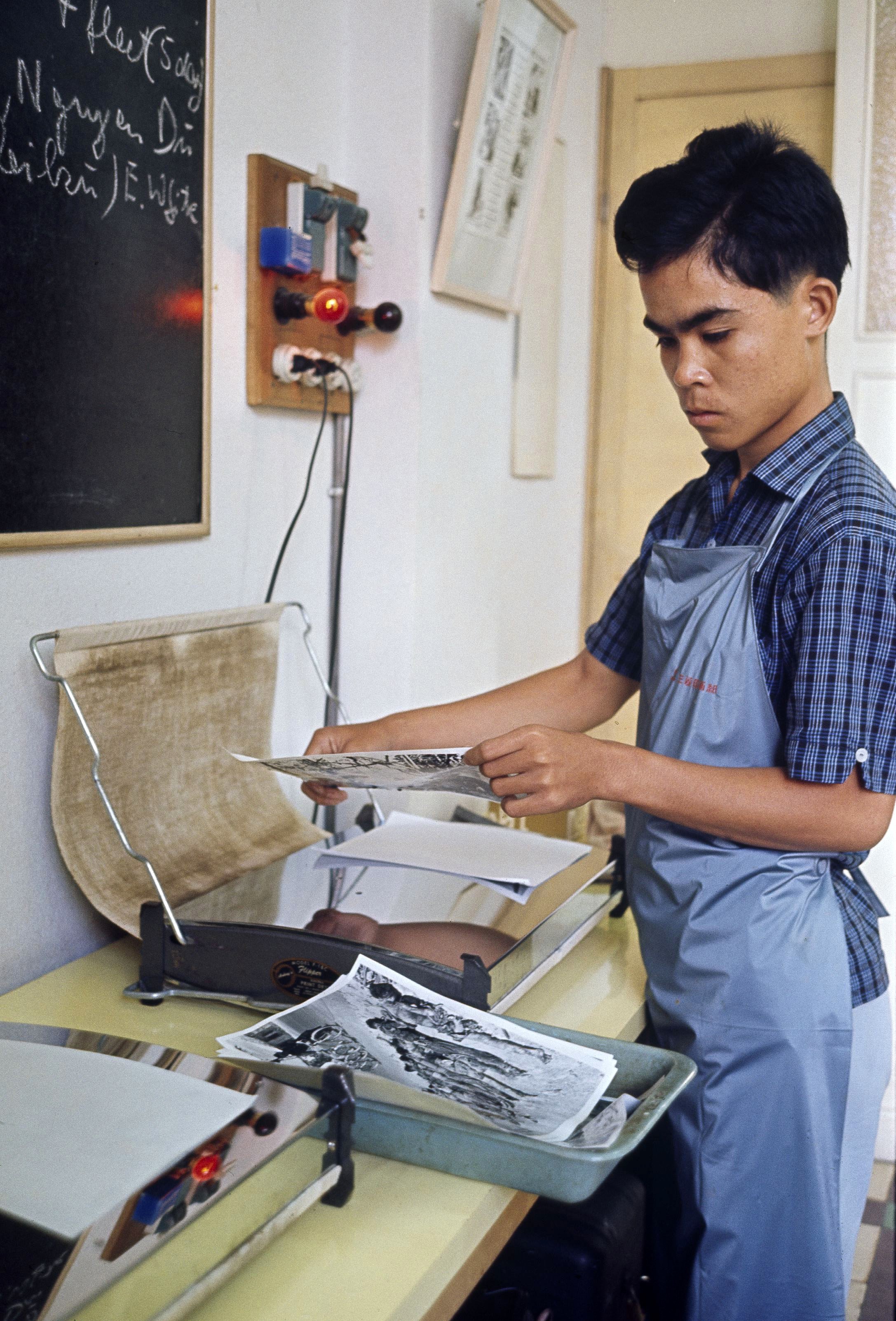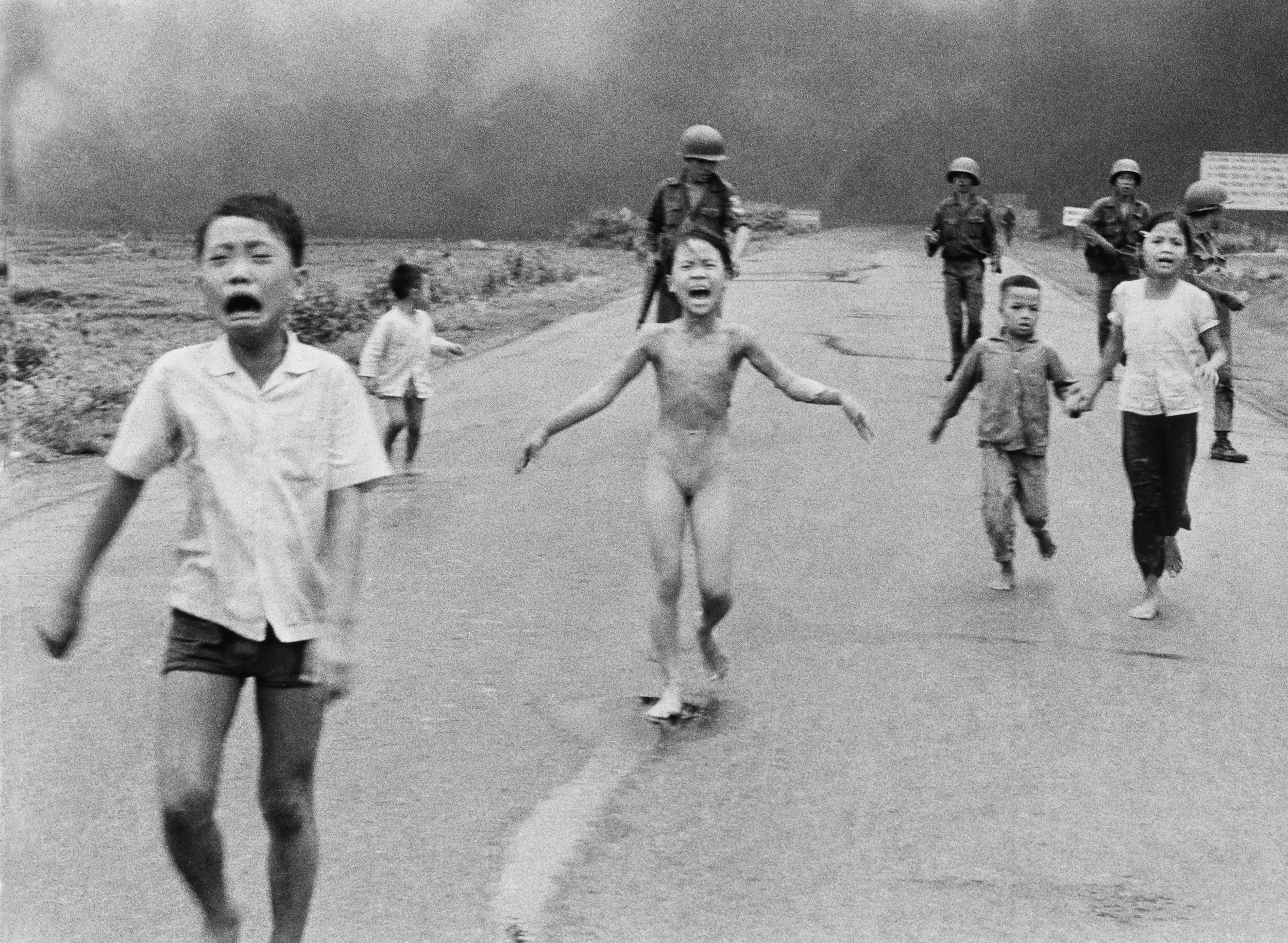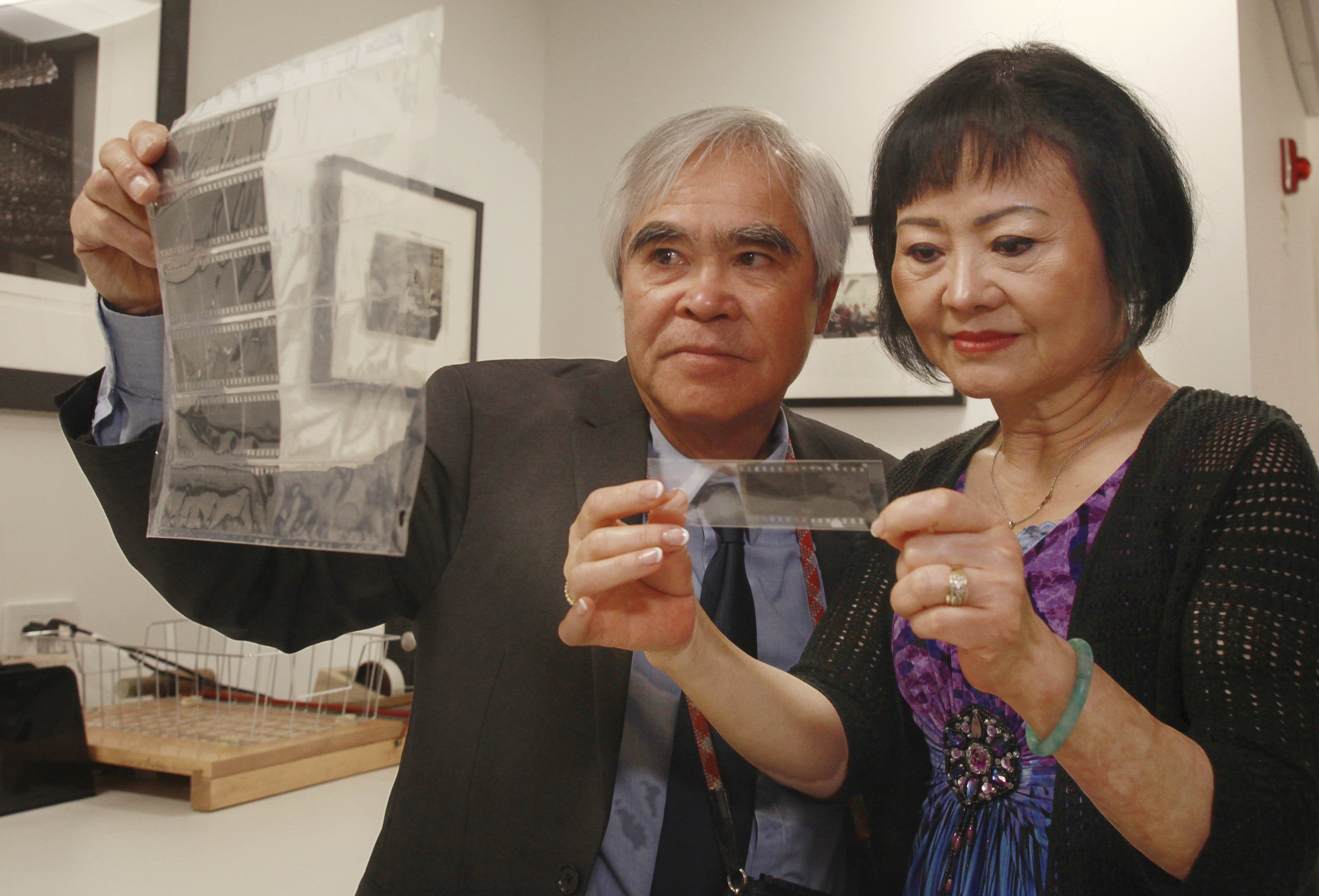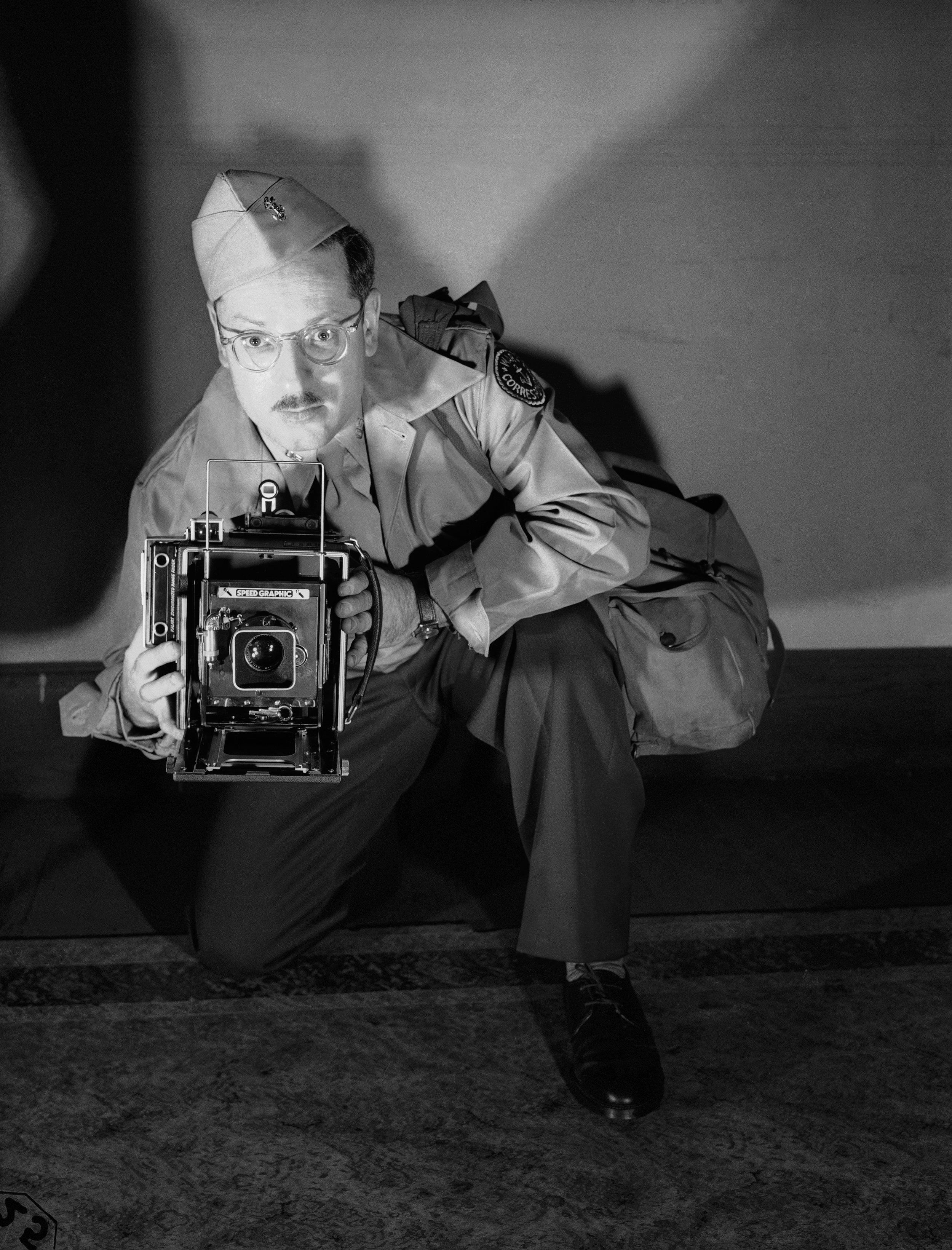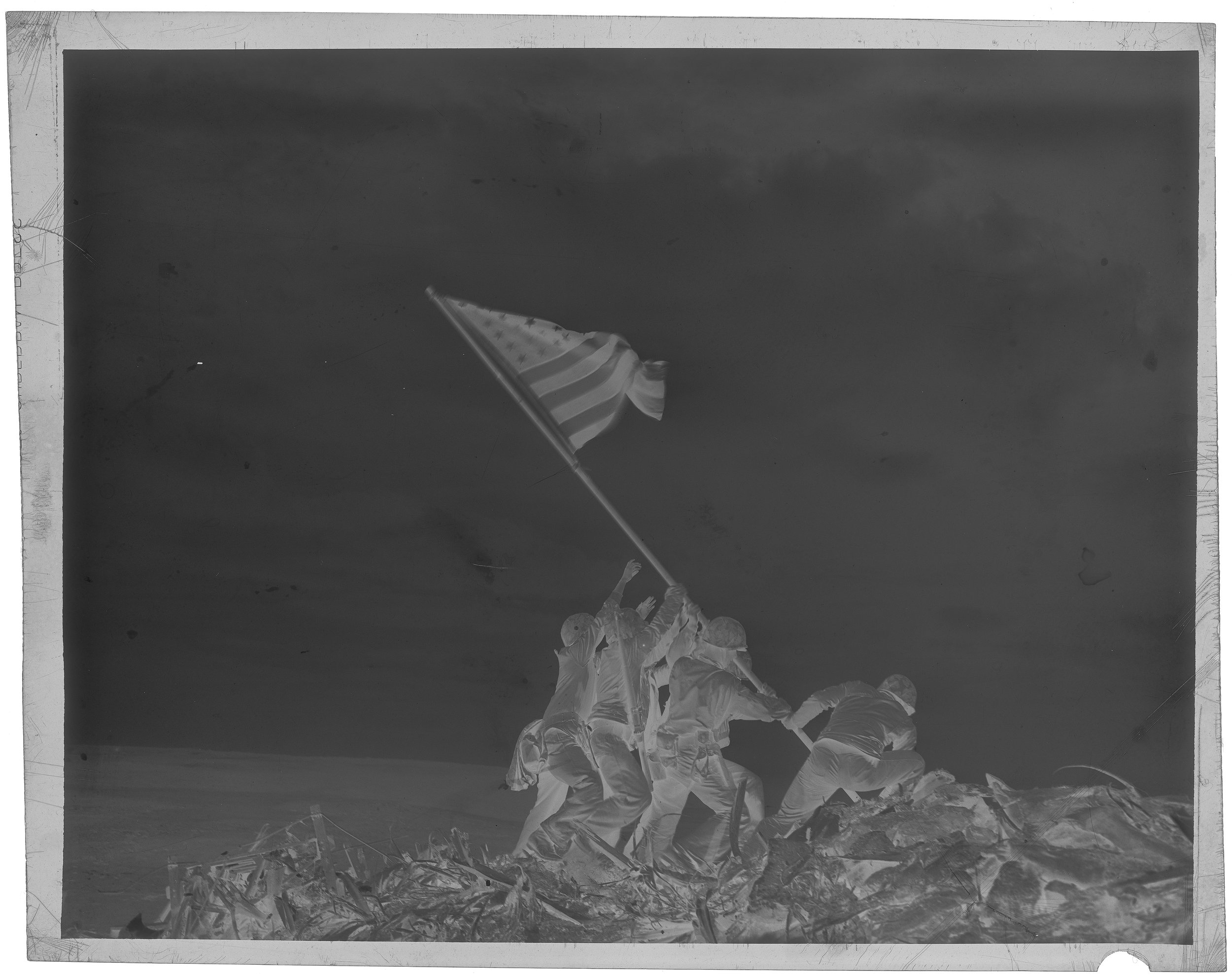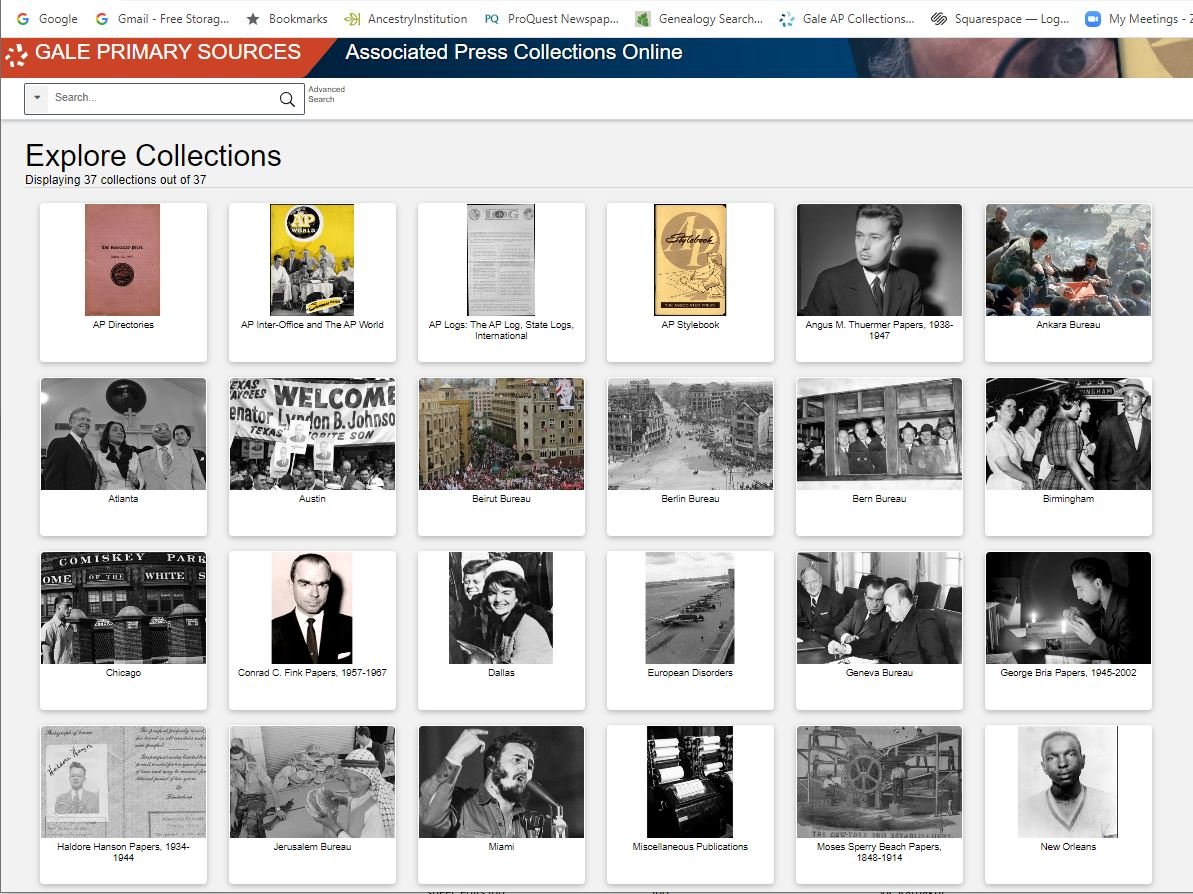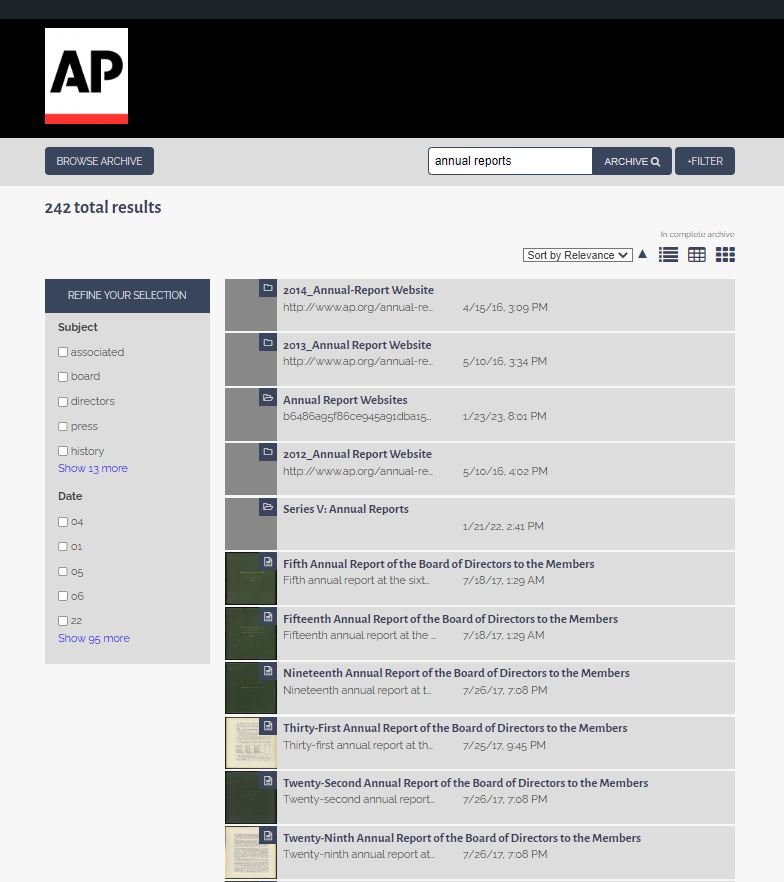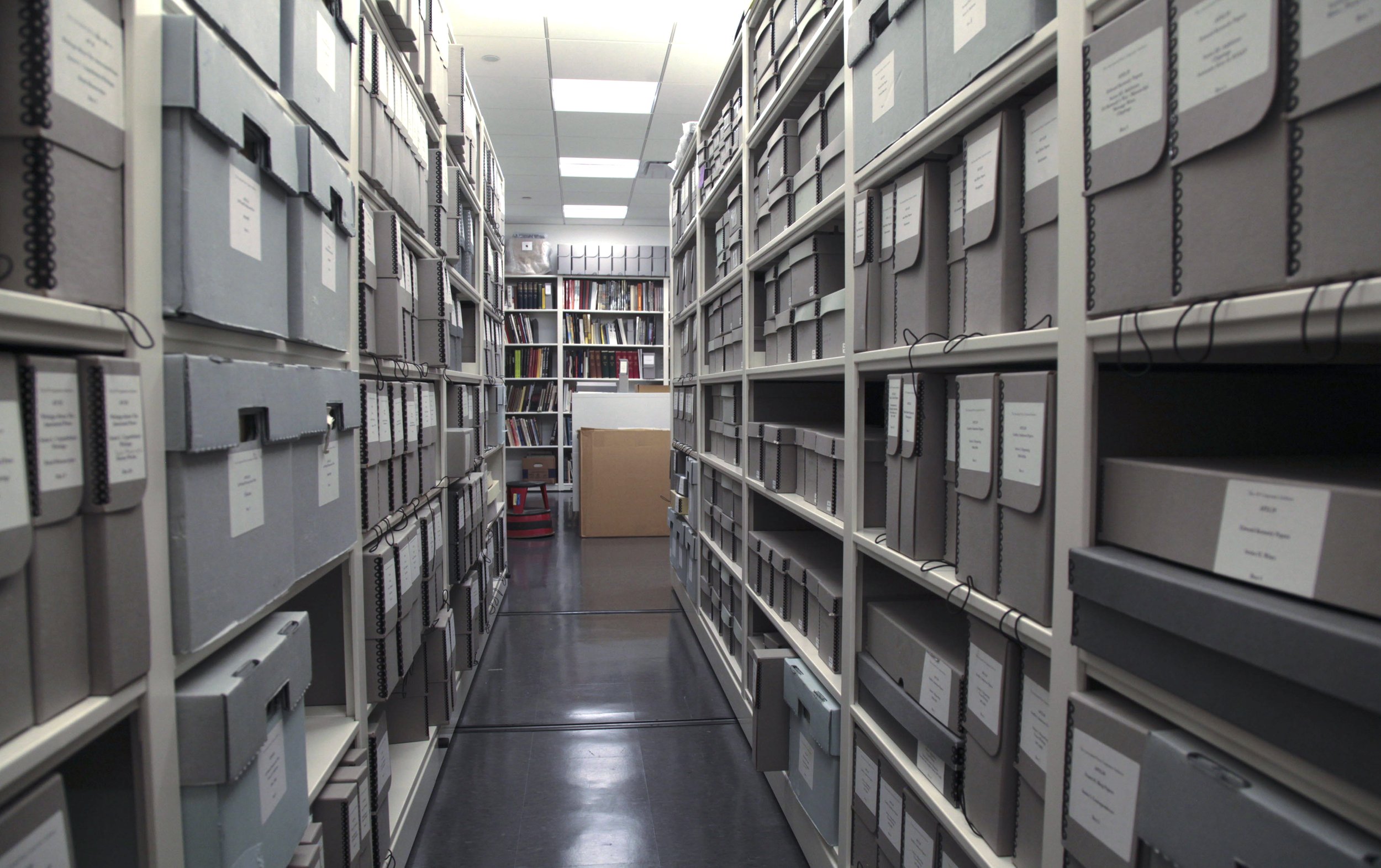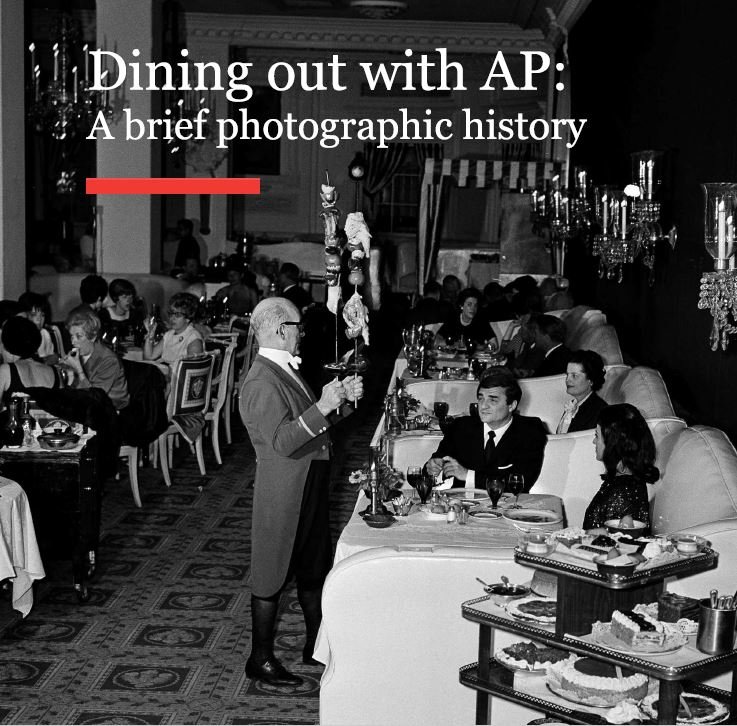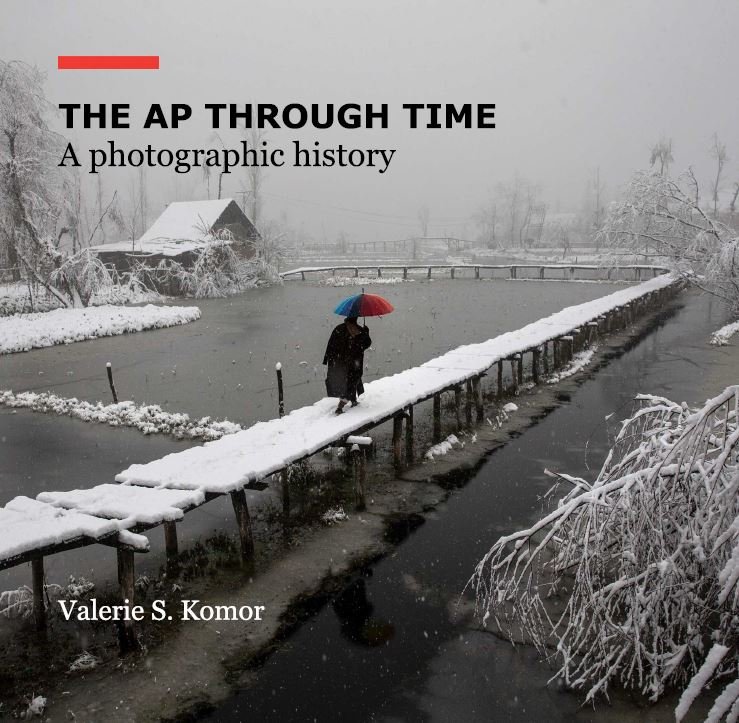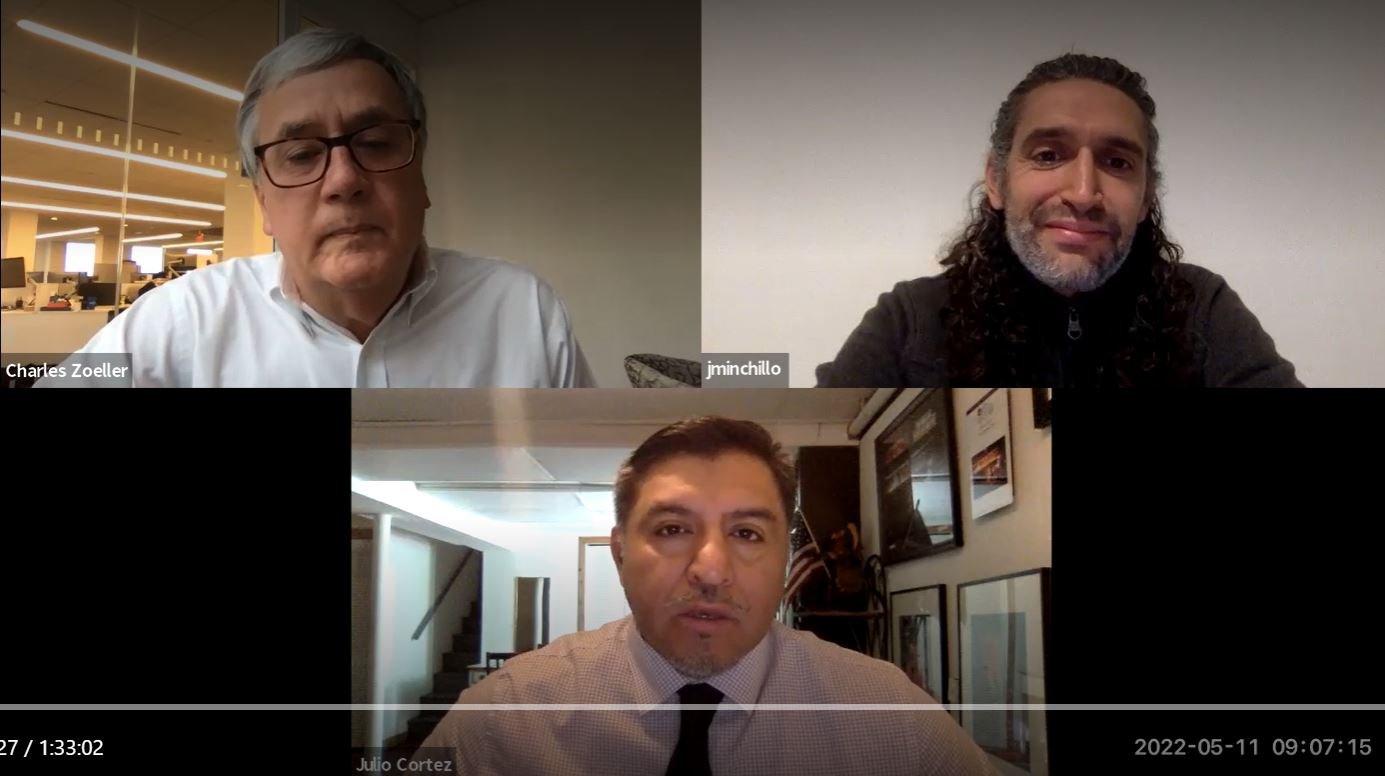The AP Corporate Archives at 20
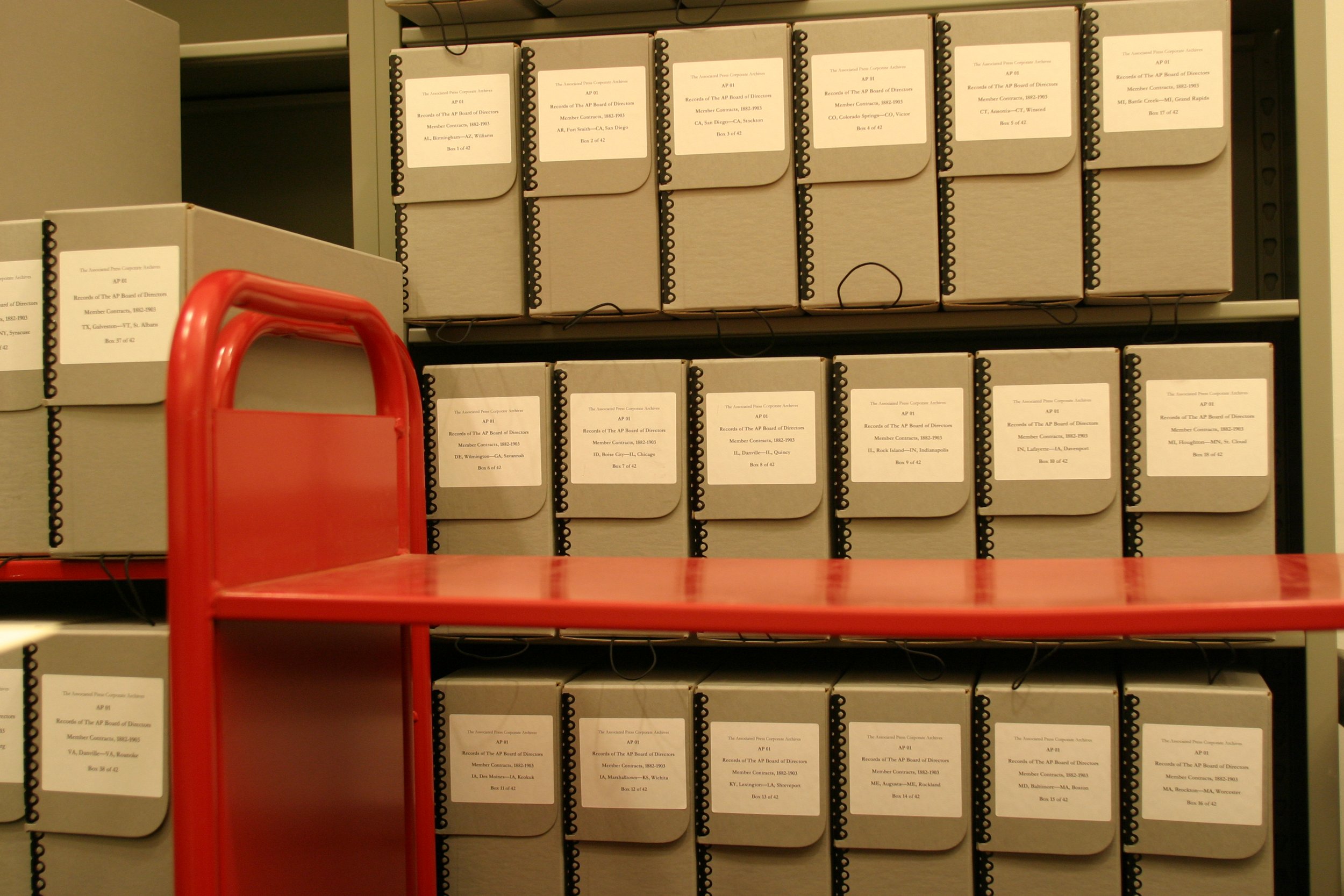
“Archives are the records, organically related, of an entity, systematically maintained, normally after they have fulfilled the purpose for which they were created, because they contain information of continuing value.”
—David Bergen Gracy II, 1941-2020
Governor Bill Daniel Professor of Archival Enterprise, Emeritus, University of Texas at Austin
Although AP traces its origins to 1846, its corporate archives was not established until 2003. During the intervening century and more, essential governing documents, such as newspaper contracts and the records of the Board of Directors, were saved by the Board Secretary. News librarians began cataloging select incoming wire copy during the 1930s, creating a set of voluminous records which were microfilmed in the 1970s on 700 reels of film and digitized by Ancestry.com in 2011.
Still, there was no formal system for documenting the institution itself, and hence no institutional node for the study of AP history. That changed in 2003 with the hiring of a professional archivist and the creation of a new department, the corporate archives, recognized by a resolution of the Board in July 2005.
From its beginnings, the archives has been a multi-faceted operation, with programs in acquisitions, collections processing, oral history, exhibitions, mini-documentaries, reference services, and digital preservation. Bureaus, offices and individuals routinely transfer their non-current records and papers, so that we now hold over 5,000 linear feet of paper records and 12 TB of digital collections. Internally, our users come from across the company and include news, administrative and commercial departments. Our outside researchers have produced numerous books and articles—too many to list! We look forward to seeing Gene Allen’s Mr. Associated Press: Kent Cooper and the Twentieth-Century World of News (Univ. of Illinois Press) due out June 20, 2023.
With this blog, we invite you to celebrate the major turning points in our work since 2003. As historian Robert Caro’s first boss at the New Brunswick Daily Home News admonished him on the eve of his journalism career: “Turn Every Page!”
A motto both journalists and archivists live by!
2003
Sr. Vice President Kelly Tunney establishes the AP Corporate Archives
Kelly Tunney joined AP in 1961 and reported from Miami, Saigon, Washington, Los Angeles and Seoul. As AP’s first female Vice President, she organized and headed the department of Corporate Communications. In July 2003, she hired Valerie Komor as AP’s first Director of Corporate Archives, serving as her mentor, friend and endless fount of AP history and lore.
At right, Kelly flies in a Huey over South Vietnam in 1967 (AP Photo).
At left, she celebrates her retirement from AP (2005), with the newly-acquired records of the Vienna Bureau behind her. (AP Photo)
Archivist Valerie Komor works in the Concourse-level basement of 50 Rockefeller Plaza identifying and re-housing archival collections long sequestered.
At left, Komor removes the early contracts between AP and its newspaper members (here, the Findlay, Ohio Daily Courier) from the Board safe and transfers them into folders and boxes, creating collection AP01, Records of the Board of Directors—the first of 40 record groups to be established.
(AP Photo)
At right, she re-boxes the records of World Services, a division formed after World War II to supply national and international news to overseas clients in 114 countries. (AP Photo)
The General Files of the Associated Press include a collection of alphabetical files known as the Subject Files. This box holds a run of files relating to AP coverage of sports. (AP Photo/Valerie Komor)
In November of 2003, Head of Facilities John O’Connor discovered an airless chamber in the Sub-Mezzanine level of 50 Rockefeller Plaza, AP headquarters since 1938. Behind a swinging bank vault door stood 50 Shaw & Walker filing cabinets. Under the flashlight’s beam, we could see the crisp letterhead of the General Office of the Associated Press, which identified these records as the administrative and editorial correspondence of the General Manager from 1897 to 1967.
Two unbelievable strokes of luck turned up the keys to the cabinet drawers as well as the original listing of the drawers’ contents, which carried a date of 1987. That listing enabled us to organize the materials in a logical manner, when sorted in an Access database. Over the ensuing months, we filled close to 400 boxes with the General Files. Had we not stumbled across this motherlode, we would have moved from Rockefeller Plaza in 2004 to 450 West 33rd Street, consigning the General Files to oblivion.
2004
AP moves from 50 Rockefeller Plaza to 450 W. 33rd Street
In November 2004, AP moved into new quarters on the far west side of Manhattan. There, we enjoyed greater processing space, a reading room, and an exhibit gallery. Collections were stored in the basement level with access via the freight elevator.
At left, Assistant Archivist Sam Markham installs an exhibit of teletype art in the large niche case on the 15th Floor. (AP Photo/Santos Chaparro)
During our years on West 33, we curated 17 exhibits on various aspects of AP history and invited the staff to our opening receptions. “I never knew what I did for a living until I met you!” exclaimed Richard Pyle, a mellifluous writer and faithful friend to the archives who had reported from Tokyo, Saigon, Washington, Beirut and the Persian Gulf, retiring in 2009 from the New York City bureau.
At right, Swann Galleries photograph historian Daile Kaplan authenticates the photography of Lewis Hine, undertaken for the Red Cross in the Balkans following World War I. (AP Photo/Santos Chaparro)
The 53 contact prints from the negative are individually numbered by the photographer and are not duplicated by the Red Cross archive at the Library of Congress nor by the George Eastman House. They are housed in a set of albums, acquired in December 2009, that belonged to AP foreign correspondent James Mills. Mills had worked with Hine during the Red Cross survey in the Balkans.
2005
A “christening,” an acquisition, and a revision of history
On Jan. 5, 2005, AP CEO Tom Curley (red sweater), joined Valerie Komor, editor Jerry Schwartz, retired World Services head Claude Erbsen, Kelly Tunney and their colleagues to toast the newly-opened corporate archives and inaugurate their use in writing a new history of AP. (AP Photo)
AP history was suddenly revised in late 2005 when we acquired family papers from the Rev. Brewster Yale Beach, the great-great-grandson of AP’s founder, Moses Yale Beach (1800-68).
Memorandum by Moses Sperry Beach, June 1872. Moses Sperry Beach Papers, AP Corporate Archives. (AP Photo)
In this memorandum, Moses Sperry Beach recollects how his father established the Associated Press “during the existence of the Mexican War in 1846-7” by hiring a daily or pony express rider who would speed news dispatches between the port of Mobile and Montgomery, AL. Mr. Riddle, the rider, was not paid unless he beat the “regular mail” by 24 hours. From Montgomery, dispatches rejoined the mail to Richmond, where they were put on the telegraph to Washington and New York.
Upon the completion of this contract, “Mr Beach offered an equal interest to each of the other papers,” and four New York City paper accepted his offer, as described. Thus was born “the associated press of this city.”
Beach’s genius was understanding how to combine the technologies of transport (boat and pony) with the new technology of the telegraph. Ultimately, the telegraph severed communication from transportation.
The revelations contained in the Beach memorandum of 1872 led AP to revise its founding date to 1846 from 1848 and to publish a news story, featured here in the Meriden (Conn.) Record-Journal, Feb. 2, 2006.
In April, the corporate archives inaugurated its lecture series with a talk by Hebrew University communications historian, Menahem Blondheim, “History Revised A New Look at the Birth of the AP.”
2006
Peter Arnett makes a major gift and the Saigon bureau reunites in New York
At left, the records of the Saigon Bureau as they were kept by bureau staff in Acle binders.
(AP Photo/Sam Markham)
At right, a hand-edited typescript by Saigon bureau chief Richard Pyle, announcing the death of his colleague and friend, Henri Huet, in a helicopter shoot-down on Feb. 11, 1972. Saigon Bureau Records, AP Corporate Archives.
Peter Arnett arrived in Saigon on June 26, 1962 and stayed for more than a decade. In 1966, he won the Pulitzer Prize for international reporting—following Malcolm Browne’s win in 1964 and Horst Faas’ photography Pulitzer in 1965. Before his return to the United States, Arnett packed up hundreds of French Acle binders containing the bureau’s hand-edited news copy and message wires and sent them to himself for safe-keeping. In early 2006, he donated the collection to the corporate archives.
No more comprehensive pre-publication journalistic account of the Vietnam War exists anywhere. Assistant Archivist Sam Markham, who was born in Saigon as the city fell in 1975, processed the collection. He started by carefully removing the fragile onion skin from the binders and placing the copy into folders and boxes. He then wrote a “finding aid” or a guide to the collection, providing valuable information about the bureau’s origins and its staff, and created a catalog record in ArchivesSpace, our catalog system. The collection was digitized in 2009 by ProQuest for its History Vault subscription service to academic libraries.
At the Tan Son Nhat airport in Saigon, likely in the summer of 1972, Associated Press staff photographer Dang Van Phuoc, far right, pours champagne to toast departing colleague, Peter Arnett. From left: Arnett's wife Nina Arnett, Peter Arnett, Richard Pyle, Dave Mason, George Esper, Horst Faas and Dang. Arnett's children are Andrew, 5, right, and Elsa, 3. (AP Photo)
On June 26, 2006, the veterans of AP’s Saigon bureau reunited at AP headquarters for an exhibit opening, panel discussion and festive dinner. CEO Tom Curley was eager to bring back AP’s far-flung alumni in order to acknowledge their courageous and often path-breaking journalism. And the corporate archives presented him with a means of doing so.
In the front row: AP CEO Tom Curley, Seymour Topping, Peter Arnett, Hugh Mulligan, George Esper, Richard Pyle, and Malcolm Browne. In the back row: Kelly Tunney, Dang Van Phuoc, Michael Putzel, Matt Franjola, Edith Lederer, Barry Kramer and Nick Ut. Those who have since passed away include Topping, Mulligan, Esper, Pyle, Browne, Franjola and Kramer. (AP Photo/Bebeto Matthews)
2007
“Breaking News” is published, the corporate archives appears on “CBS Sunday Morning,” and we remember the Little Rock Nine
In May 2007, after more than two years of archival research, writing and editing, Princeton Architectural Press published Breaking News: How the Associated Press Has Covered War, Peace and Everything Else, the first history of AP since 1940. VP Kelly Tunney and retired Special Correspondent Walter Mears supervised the group of AP writers who, in many cases, wrote about the beats they had covered—aviation, elections, civil rights, sports, trials, foreign correspondence, disasters, the White House, elections, and war.
At right, CEO Tom Curley (foreground), editor Jerry Schwartz, reporter Richard Pyle, sports editor Darrell Christian, and editor Larry Heinzerling sign copies of the book for AP staff. (AP Photo/Santos Chaparro)
To mark the publication of “Breaking News,” CBS Sunday Morning host Charles Osgood visited the archives offices at 450 W. 33rd Street to interview Valerie Komor and tour the collections. They talked about the mission of the archives, AP’s newly revealed origins, and the fine line between history and journalism. The segment aired on May 27, 2007. (AP Photo/Santos Chaparro)
At left, members of the public and the press attend the opening of the AP corporate archives exhibit, “With All Deliberate Speed: the AP in Little Rock,” at the Clinton School of Public Service in Little Rock, Ark., Sep. 12, 2007. Relman Morin won the Pulitzer Prize in 1958 for his spot news reporting from a phone booth outside Central High School and went on to cover the integration crisis across the South. (AP Photo)
At right, the nine Black students who had tried to integrate Central High on Sept. 27, 1957, only to be stopped by rioting mobs, leave school after their first full day of classes on Oct. 2, 1957. (AP Photo/Ferd Kaufman)
2008
The archives staff grows; we commemorate the assassination of President John F. Kennedy
An archivist with wide experience in New York City repositories, Francesca Pitaro joined AP full time in 2008. Here, she is pictured with colleagues (from left) Sam Markham and Valerie Komor, and friends, Audrey Topping and her husband, retired AP foreign correspondent Seymour (“Top”) Topping. Top had come to the archives to present his memoir, “On the Front Lines of the Cold War: An American Correspondent’s Journal from the Chinese Civil War to the Cuban Missile Crisis and Vietnam.
“A former editor of The New York Times sits down to write his memoir and the title alone runs 24 words. But what else,” wrote Richard Pyle in his book review, “one might ask, was a reporter with Topping’s breadth and depth of experience to do?” (AP Photo/Chuck Zoeller)
Exhibit leaflet, “AP Covers the Assassination of President John F. Kennedy,”
Nov. 22, 2008.
In addition to the three photos made by Dallas wirephoto operator, Ike Altgens, this exhibit featured never-before-seen TTS (teletypesetter circuit) wire copy, hand-edited at New York’s General Desk on November 22, 1963 and in ensuing days.
Working quickly under enormous pressure, the editor pulled the sheet from the incoming printer as it continued to type, forcing a cascade of single letters down the page. The editor supplied the fractured text in pencil, creating a startling graphic counterpoint to the tragedy unfolding.
2009
CEO Tom Curley sends the archivist to the Middle East to augment the archival collections
In March, Valerie Komor travelled to Beirut, Damascus, Nicosia, Amman and Cairo to survey and pack up bureau records for shipment to New York. At each stop, she conducted oral history interviews on camera with local staff in order to document the singular experiences of journalists with deep roots in the region. These interviews are now part of the archives’ oral history collection, which holds nearly 300 interviews.
John Halaby (left), March 19, 2009, Amman, Jordan. (AP Photo/Valerie Komor)
Hamza Hendawi (right), March 9, 2009, Beirut, Lebanon. (AP Photo/Valerie Komor)
Komor interviewed longtime Amman correspondent, John Halaby (1923-2012) on March 19, 2009 at his family’s home outside Amman. Preceded by a sumptuous feast prepared by the Halaby family, the interview ranged over Halaby’s 70 years in journalism during the turbulent 20th century in the Middle East, including the 1948 Arab Israeli War, the overthrow of King Faisal II of Iraq, civil war in Yemen, and the reigns of King Hussein and his son, King Abdullah of Jordan.
Hamza Hendawi was visiting the Beirut bureau prior to heading back to Baghdad when Komor interviewed him on March 9, 2010. Hendawi, one of AP’s most gifted writers, came of age in the shadow of the Egyptian defeat in the 1967 Six-Day War:
“[I]t was something that perhaps deep down in the soul of every Egyptian, that defeat scarred the soul. But it wasn’t just a military defeat. I mean, nations do suffer military defeats and rise and regain the territory they’ve lost or they regain their standing or self-esteem. But that defeat was particularly painful for everyone because of how it happened, how fast it happened….But it was also, as I said, the end of a dream that was built dating back to the Suez Crisis when Nasser emerged as not just a leader of Egypt but the leader of the entire Arab world.”
In “The Costs of War,” Komor describes three exceptional wartime bureaus in the Middle East: Beirut, Kabul and Baghdad. Drawing upon newly retrieved documentation and oral history interviews, this little book spotlights those who choose to witness war and its suffering up close.
“There was a time when just coming to work [in Baghdad] could be a question of life and death,” writes Komor, quoting from an interview. “Some thought it too dangerous to carry a notebook and simply memorized their stories. Many of these staffers could have fled to Jordan and Syria like hundreds of thousands of others, but they chose to stay and sacrifice not only because they wanted to earn their living but also because they believed in AP’s mission. They wanted to tell the truth.”
2010
Bureau surveys and oral history interviews continue in Shanghai, Beijing and Tokyo
At left, Tetsuko Itagagi, retired confidential secretary, Tokyo bureau, at lunch with Ritsuko Yamamoto, her successor, Oct. 20, 2010. (AP Photo/Valerie Komor)
In October of 2010, Valerie Komor visited the bureaus in Shanghai, Beijing and Tokyo. At the Tokyo bureau, she interviewed Tetsuko Itagaki, Shigyoshi Kimura, Yuri Kageyama, Kazuo Abiko, Asayo Emura and Michio Yoshida. Yoshida-san, a photographer, had served in the Japanese Army during the war and recalled seeing the faces of American bomber pilots as they flew low over Tokyo. He had never spoken about his wartime service before.
Tetsuko Itagaki worked as executive assistant for five Tokyo bureau chiefs from 1958 to 1989, including John Randolph, Bob Eunson, Henry Hartzenbusch, and Tom Dygard. She was a college student studying English literature when war broke out between the U.S. and Japan on Dec. 7, 1941. She recalled where she was when she learned the war had ended.
“And I left early in the morning and arrived at Karuizawa late at night, but my parents are very pleased that I could visit them. The following morning, there was—someone came and said, “Today at noon, the Emperor is going to speak to the people, so please come and listen to radio.” And we didn’t have any radio at home, but there was a lady who owned a radio very nearby, so my mother and I went up to the house and there, there was radio, and a few people sat around it. And I thought, What was emperor going to say? Maybe he would tell us to work harder and {laughs} persevere or something.
And then he spoke in very special language, very hard to learn, but—to hear—but I managed that the war was going to be over. He said he was quite upset this—with this new bomb, new cruel bomb on Hiroshima and so on, and he said he was going to end the war. So I said to my mother, “The war is over.” And the radio is over, and I went back to the house and told my father it was a non-conditional surrender. And he said, ‘Good.’ So.”
Tetsuko Itakagi (front row, left), Valerie Komor (front row, right), and Shigeyoshi Kimura (back row, right) join Yoshihiro Takishita (back row, left) at his home in Kamakura, Japan on Oct. 29, 2010.
Takishita is the adopted son of late AP Special Correspondent, John Roderick, who covered Mao Zedong in the caves at Yan’an, his rise to power, and after the Communist Revolution, continued covering China from Hong Kong and Tokyo.
2011
AP signs an agreement with Ancestry.com and we commemorate the 150th anniversary of Lincoln’s inauguration
In January 2012, Francesca Pitaro and Valerie Komor packed up the AP news microfilm and two million name and subject index cards to send to Ancestry.com for digitization. For the first time, researchers have online access to a historic span of pre-publication stories (1937-85) from AP’s own holdings.
(AP Photo/Santos Chaparro)
Exhibit leaflet, “Long Remembered: The Associated Press with Lincoln at the First Inaugural and Gettysburg,” March 4, 2011.
When Lincoln took the oath of office on March 4, 1861, Lawrence A. Gobright (1816-1881), our Washington Agent, had been a journalist in that city for nearly 30 years. Well known around town, he enjoyed remarkably easy access to the president, calling on him unannounced at the White House to “learn the latest news.” The relationship was useful to both men.
Joseph Ignatius Gilbert (1842-1926) was a 21-year-old stenographer at the state capitol in Harrisburg when Gobright tapped him to cover the president’s speech at Gettysburg, Pennsylvania on Nov. 19, 1863. Amazingly, this was the second time Gilbert had covered Lincoln, so he was familiar with the cadences of his high-pitched voice—a decided advantage.
As Lincoln began speaking, Gilbert took down the president’s words, got distracted by his oratory, stopped writing, and then borrowed the president’s delivery text to fill in his copy before telegraphing it to New York. Lincoln later relied on the AP version of the address in making his fair copies to give to friends. He probably recalled loaning his text to the AP’s Mr. Gilbert.
Lawrence A. Gobright (right), AP Washington Agent. (Library of Congress, Prints and Photographs Division, Washington, D.C.).
Joseph Ignatius Gilbert (left), stenographer at the capital of Harrisburg, PA.
(Photo courtesy of Brenda Malloy Palley).
Three versions of the Gettysburg Address in newspapers: from left, The Brooklyn Daily Eagle (the AP account), The New York Times, and The Chicago Tribune.
It is fascinating to compare the differing versions of the Address that appeared in American newspapers. The Chicago Tribune had its agent in the New York Associated Press offices, but it chose not to take the AP report and instead used that of its own reporter. He had difficulty getting through on Nov. 19 and had to send his complete copy on Nov. 20 from Harrisburg.
The text is garbled in places, suggesting he may not have heard the president well (“government the people founded, by the people shall not perish.”) However, “poor power” and “unfinished work” got through, whereas neither “poor” nor “unfinished” made it into the AP report.
2012
A wartime memoir by Ed Kennedy and an apology to him from AP after 67 years
At AP headquarters in New York, guests and panelists gather in the conference center, May 8, 2012. (AP Photo/Chuck Zoeller)
Above, Ed Kennedy’s War: V-E Day, Censorship, and The Associated Press (2012)
To mark the 67th anniversary of V-E Day, The Associated Press and the Overseas Press Club held a panel discussion, book signing, and reception for Ed Kennedy’s War: V-E Day, Censorship, and The Associated Press, a memoir by AP Paris Bureau Chief Ed Kennedy, edited by Julia Kennedy Cochran, with an introduction by Tom Curley and Jack Hamilton. In his introduction, Curley offered an apology to Kennedy for AP’s treatment of him in 1945.
On May 7, 1945, Kennedy broke the biggest story of the day: the ending of World War II in Europe. Unfortunately, the scoop cost him his AP career, as his bosses (notably Board Chairman Robert McLean) believed he had violated a verbal pledge to hold the story (in essence political censorship)
so that Josef Stalin could announce the USSR’s defeat of Germany in Berlin ahead of the Allies.
Kennedy’s story generated instant controversy. Rival news organizations angrily protested, and the AP recalled him immediately and fired him in December 1945. His press credentials were revoked although later reinstated by President Dwight D. Eisenhower.
Richard Fine, Professor of English at Virginia Commonwealth University, has just written a definitive account of these events, “The Price of Truth,” which is based in part upon the personal papers of Ed Kennedy, donated to the AP Corporate Archives in 2012 by his daughter, Julia Kennedy Cochran.
2013
We make the first in a series of 16 mini-documentaries highlighting AP coverage of historic events
Contact sheet showing images made by Malcolm Browne while covering the Buddhist Crisis in Saigon, June 11, 1963. AP Photo Library. (Photo by Sean M. Thompson, AP Photo Library).
For the first in our series of mini-documentaries, we chose to examine how Saigon correspondent Malcolm Browne made his picture of the self-immolation of Buddhist monk Thich Quang Duc.
The harrowing image (selected in yellow wax pencil above, first in middle row) moved within the hour it was taken. At the White House, President John F. Kennedy saw it in the papers and exclaimed, "Jesus Christ!" He then ordered a review of his administration's Vietnam policy.
Browne won the Pulitzer Prize for International Reporting in 1964. This photograph was part of his Pulitzer submission package, now held at the Columbia University Rare Book and Manuscripts Library. It remains one of the instantly recognizable images from the Vietnam War.
Malcolm Browne died on August 27, 2012 at his home in Hanover, New Hampshire.
“A Gift of One Picture: Nick, Kim, and the Napalm Girl,” another mini-documentary, traces the relationship between the young Vietnamese photographer, Nick Ut (left, working in the Saigon bureau in 1966) and Phan Thi Kim Phuc, the child burned by napalm whose life Ut saved after lifting his camera as she ran toward him on June 8, 1972 (center). Kim went on to serve as a UNESCO Goodwill Ambassador, inspiring many others healing from the wounds of war.
At right, photographer Nick Ut holds the original negative of the iconic photo at the AP Photo Library in New York, Monday, June 6, 2022. Their joint visit, their first to AP headquarters, marked the 50th anniversary of the picture. (AP Photo/Chuck Zoeller)
Left, AP staff photographer Joe Rosenthal poses with his Speed Graphic in San Francisco prior to his departure for Honolulu and a pool assignment with the Pacific fleet, March 25, 1944. (AP Photo/Ernest K. Bennett)
Center, original negative envelope for an image of a jeep crossing the beach on Iwo Jima, Feb. 26, 1945. (AP Photo)
Right, the original negative of the raising of the American flag on Iwo Jima, Feb. 23, 1945. (AP Photo/Joe Rosenthal)
For the min-documentary, “Conspicuous Gallantry: Joe Rosenthal and The Flag-Raising on Iwo Jima,” we combined Rosenthal’s own words with a variety of archival texts and images (including the original negative, to explain just how one man made shot one enduring picture on Feb. 23, 1945.
“When I look at a copy of that picture, myself, I don’t know, almost invariably, I see D-Day. I see what it took out of a lot of young men to get to that point, and I feel a strange kind of, yes--I’m as egocentric I think as any news photographer. I feel a gratification that the use of the picture, in general, has been very good uses.
But I see what had to be gone through before those Marines, with that flag, or with any flag, got up to the top of that mountain and secured the highest point, the most important point, perhaps, in the entire battle, the most important ground to be taken by those Marines.”
--Joe Rosenthal, AP Oral History Interview, 1997
2014
Under a revenue share agreement with AP, content provider Gale/Cengage publishes “Associated Press Collections Online,” bringing two million pages of archival content into academic libraries.
Screenshot from “AP Collections Online” showing some of the 37 personal papers and bureau records collections available to search on the Gale site. This set of materials, which spans 1848 to 2010, proves popular in academic libraries and brings royalties to AP.
2015
AP signs a contract with Preservica for a digital preservation system, and Sarit Hand is promoted to Digital Archivist
Sarit Hand, Digital Archivist, at New York headquarters, Feb. 10, 2017.
(AP Photo/Chuck Zoeller)
Sarit Hand, who joined the Corporate Archives in 2005 with responsibility for managing oral history (and later the AP Radio archive), took on the newly-created role of Digital Archivist in 2015. As our liaison to Preservica, Sarit learned the system inside and out, encountering its weaknesses as well as its strengths. She has positioned us to acquire, accession, describe and preserve the burgeoning digital record.
Screenshot showing a portion of AP01, Records of the Board of Directors, ingested into Preservica for long-term active preservation.
2016
AP launches an E-book program with Amazon
Bookshelves in the AP Corporate Archives, Jan. 12, 2023.
(AP Photo/Valerie Komor)
With Amazon, AP begins publishing books drawn upon resources in the corporate archives. Among the earliest titles are Peter Arnett’s Saigon Has Fallen, Kathryn Johnson’s My Time With the Kings: A Reporter’s Recollections of Martin, Coretta and the Civil Rights Movement, and Hugh Mulligan’s Mulligan’s Christmas Stew: A Tasty Serving of Holiday Stories. More recently, Little, Brown and Company released Jill, a biography of the First Lady, by Julie Pace and Darlene Superville, drawing upon the in-depth reporting of these two White House veterans.
2017
AP moves to 200 Liberty Street from 450 W. 33rd, returning to its earliest neighborhood, Newspaper Row, where it had offices at the southwest corner of Broadway and Liberty in the 1840s
Stack area, AP Corporate Archives, 200 Liberty Street, New York.
(AP Photo/Valerie Komor)
Having spent the better part of 2016 preparing our collections for the move, in early 2017, we transferred 1,088 boxes and our general reference library of 850 volumes to 200 Liberty Street on the 20th Floor.
The remaining two-thirds of our holdings went to AP’s Cranbury Technical Center in Cranbury, N.J.
As of this writing, collections are being prepared to move from Cranbury to Patterson, New York where Clancy Cullen has library and archival storage facilities. We will be able to call for collections at any time.
2018
Valerie Komor interviews Kathryn Johnson and Ambassador Andrew Young about Johnson’s career reporting civil rights for AP at the Carter Presidential Library and Museum in Atlanta
Retired AP reporter Kathryn Johnson with her good friend, Ambassador Andrew Young, Carter Presidential Library and Museum, Atlanta on April 17, 2018. Kathryn had just signed copies of her memoir, My Time With the Kings, for an eager crowd. (AP Photo/Robert Ray)
2019
Preservica synchronizes with ArchivesSpace
Screenshot from Preservica, showing a listing of digital objects.
Preservica, our digital preservation system, and ArchivesSpace, our cataloging system, begin synchronization, a process that allows the two systems to share one set of metadata. Thus, users can click on a link in ArchivesSpace to the digital object in Preservica.
2020
During the COVID-19 pandemic, we discover Blurb book-publishing software
During the early months of the COVID-19 pandemic, in the spring of 2020, Valerie Komor composed two E-books using Blurb software: Dining Out with AP: A Brief Photographic History, and The AP Through Time: A Photographic History. Both books draw upon AP’s rich photograph and archival collections and are available on the Blurb website.
2021
AP celebrates its 175th birthday
Screenshot of the eight-part blog, “AP at 175”
To mark AP’s 175th birthday, we create an eight-part blog offering a concise visual history of the organization. You can find the blog here.
2022
We begin a consultancy with AVP to enhance our digital preservation practices in Preservica
We conduct oral history interviews to document our coverage of the January 6, 2021 insurrection at the U.S. Capitol
Screen grab from an oral history video showing Chuck Zoeller (upper left), John Minchillo (upper right) and Julio Cortez (center), May 11, 2022
Retired Special Projects Manager for Creative Services, Chuck Zoeller, interviews Washington photographer Julio Cortez and New York bureau photographer John Minchillo via Zoom on May 11, 2022 about their harrowing experiences on Jan. 6, 2021. Thankfully, both men escaped serious injury that day.
Screen grab from an oral history video showing Scott Applewhite (upper left), Valerie Komor (upper right) and Andrew Harnik (center), June 29, 2022
Valerie Komor listens as Washington photographers Scotty Applewhite and Andrew Harnik interview one another on June 29, 2022. Both managed to remain inside the House chamber on Jan. 6, 2021, which is where they wanted to be, in spite of the mounting danger to themselves.
As we contemplate the archives’ next 20 years, one constant remains to guide us: the privilege of preserving the legacy of Scotty, Andrew, Julio, John, Kathryn, Hamza, Kelly, and so many others. They make us proud to be archivists.
Photo editing and text by Valerie Komor

